(PDF) Anxiety disorders in older adults
VerifiedAdded on 2021/06/17
|34
|9370
|58
AI Summary
Contribute Materials
Your contribution can guide someone’s learning journey. Share your
documents today.
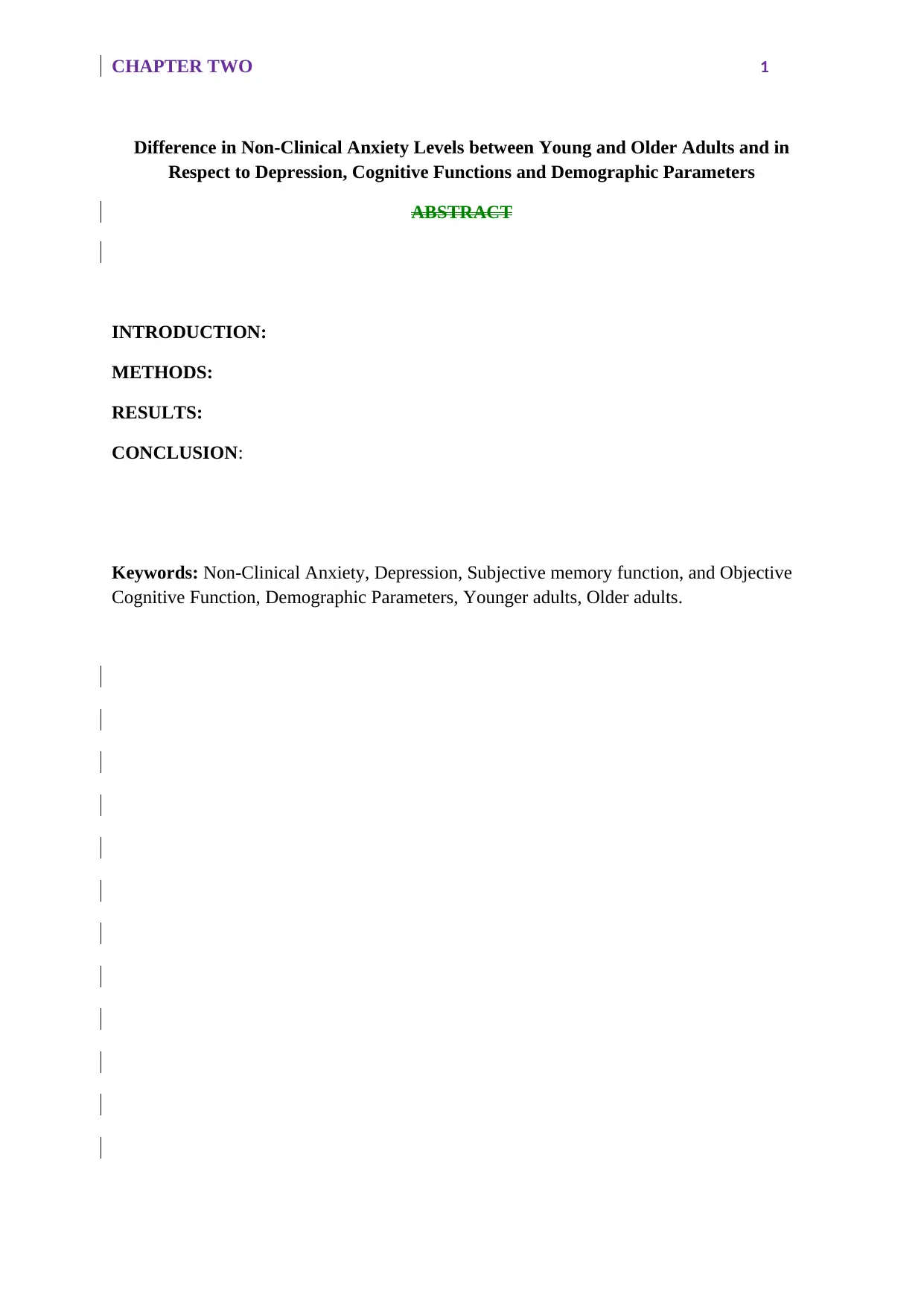
CHAPTER TWO 1
Difference in Non-Clinical Anxiety Levels between Young and Older Adults and in
Respect to Depression, Cognitive Functions and Demographic Parameters
ABSTRACT
INTRODUCTION:
METHODS:
RESULTS:
CONCLUSION:
Keywords: Non-Clinical Anxiety, Depression, Subjective memory function, and Objective
Cognitive Function, Demographic Parameters, Younger adults, Older adults.
Difference in Non-Clinical Anxiety Levels between Young and Older Adults and in
Respect to Depression, Cognitive Functions and Demographic Parameters
ABSTRACT
INTRODUCTION:
METHODS:
RESULTS:
CONCLUSION:
Keywords: Non-Clinical Anxiety, Depression, Subjective memory function, and Objective
Cognitive Function, Demographic Parameters, Younger adults, Older adults.
Secure Best Marks with AI Grader
Need help grading? Try our AI Grader for instant feedback on your assignments.
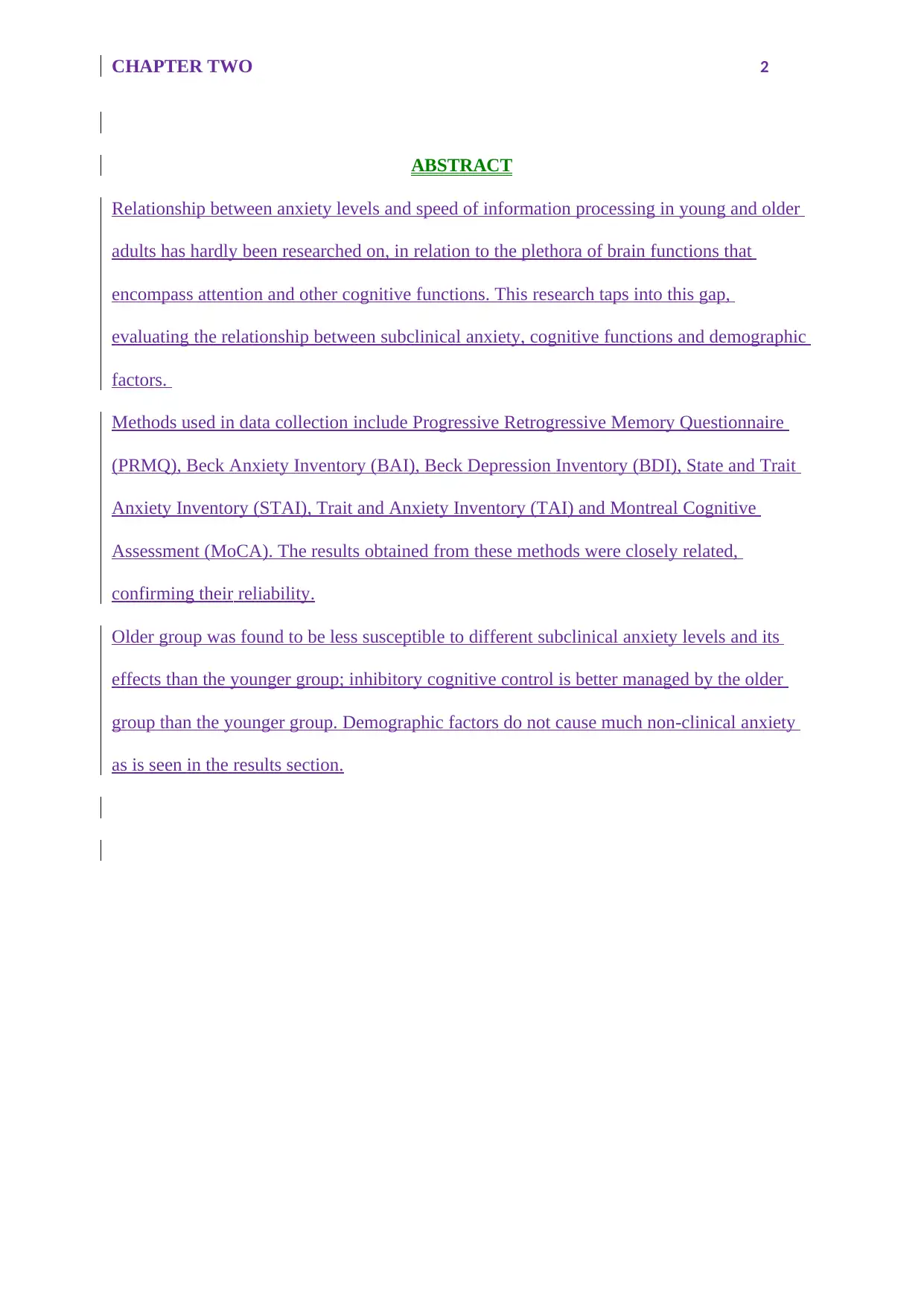
CHAPTER TWO 2
ABSTRACT
Relationship between anxiety levels and speed of information processing in young and older
adults has hardly been researched on, in relation to the plethora of brain functions that
encompass attention and other cognitive functions. This research taps into this gap,
evaluating the relationship between subclinical anxiety, cognitive functions and demographic
factors.
Methods used in data collection include Progressive Retrogressive Memory Questionnaire
(PRMQ), Beck Anxiety Inventory (BAI), Beck Depression Inventory (BDI), State and Trait
Anxiety Inventory (STAI), Trait and Anxiety Inventory (TAI) and Montreal Cognitive
Assessment (MoCA). The results obtained from these methods were closely related,
confirming their reliability.
Older group was found to be less susceptible to different subclinical anxiety levels and its
effects than the younger group; inhibitory cognitive control is better managed by the older
group than the younger group. Demographic factors do not cause much non-clinical anxiety
as is seen in the results section.
ABSTRACT
Relationship between anxiety levels and speed of information processing in young and older
adults has hardly been researched on, in relation to the plethora of brain functions that
encompass attention and other cognitive functions. This research taps into this gap,
evaluating the relationship between subclinical anxiety, cognitive functions and demographic
factors.
Methods used in data collection include Progressive Retrogressive Memory Questionnaire
(PRMQ), Beck Anxiety Inventory (BAI), Beck Depression Inventory (BDI), State and Trait
Anxiety Inventory (STAI), Trait and Anxiety Inventory (TAI) and Montreal Cognitive
Assessment (MoCA). The results obtained from these methods were closely related,
confirming their reliability.
Older group was found to be less susceptible to different subclinical anxiety levels and its
effects than the younger group; inhibitory cognitive control is better managed by the older
group than the younger group. Demographic factors do not cause much non-clinical anxiety
as is seen in the results section.
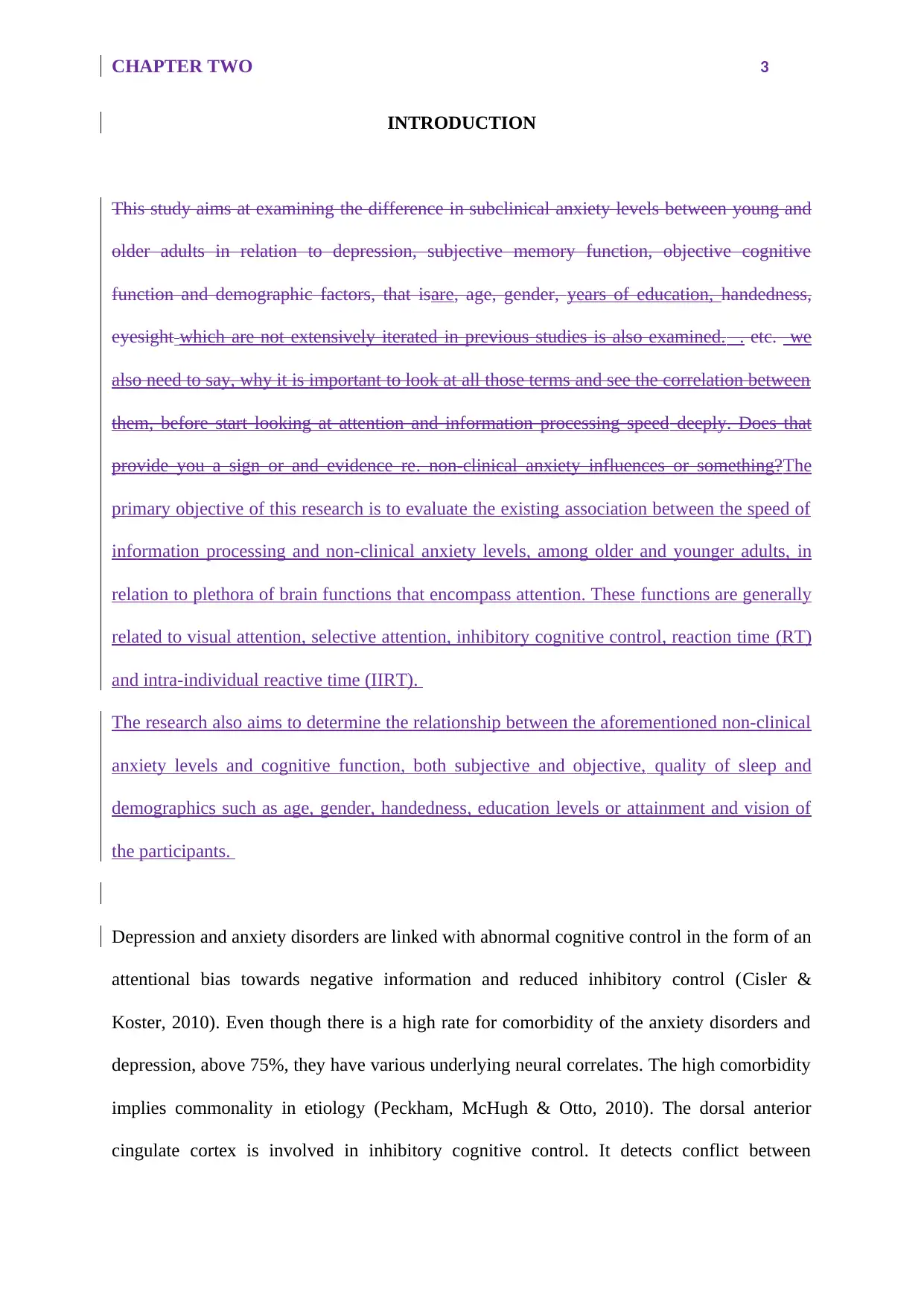
CHAPTER TWO 3
INTRODUCTION
This study aims at examining the difference in subclinical anxiety levels between young and
older adults in relation to depression, subjective memory function, objective cognitive
function and demographic factors, that isare, age, gender, years of education, handedness,
eyesight which are not extensively iterated in previous studies is also examined. . etc. we
also need to say, why it is important to look at all those terms and see the correlation between
them, before start looking at attention and information processing speed deeply. Does that
provide you a sign or and evidence re. non-clinical anxiety influences or something?The
primary objective of this research is to evaluate the existing association between the speed of
information processing and non-clinical anxiety levels, among older and younger adults, in
relation to plethora of brain functions that encompass attention. These functions are generally
related to visual attention, selective attention, inhibitory cognitive control, reaction time (RT)
and intra-individual reactive time (IIRT).
The research also aims to determine the relationship between the aforementioned non-clinical
anxiety levels and cognitive function, both subjective and objective, quality of sleep and
demographics such as age, gender, handedness, education levels or attainment and vision of
the participants.
Depression and anxiety disorders are linked with abnormal cognitive control in the form of an
attentional bias towards negative information and reduced inhibitory control (Cisler &
Koster, 2010). Even though there is a high rate for comorbidity of the anxiety disorders and
depression, above 75%, they have various underlying neural correlates. The high comorbidity
implies commonality in etiology (Peckham, McHugh & Otto, 2010). The dorsal anterior
cingulate cortex is involved in inhibitory cognitive control. It detects conflict between
INTRODUCTION
This study aims at examining the difference in subclinical anxiety levels between young and
older adults in relation to depression, subjective memory function, objective cognitive
function and demographic factors, that isare, age, gender, years of education, handedness,
eyesight which are not extensively iterated in previous studies is also examined. . etc. we
also need to say, why it is important to look at all those terms and see the correlation between
them, before start looking at attention and information processing speed deeply. Does that
provide you a sign or and evidence re. non-clinical anxiety influences or something?The
primary objective of this research is to evaluate the existing association between the speed of
information processing and non-clinical anxiety levels, among older and younger adults, in
relation to plethora of brain functions that encompass attention. These functions are generally
related to visual attention, selective attention, inhibitory cognitive control, reaction time (RT)
and intra-individual reactive time (IIRT).
The research also aims to determine the relationship between the aforementioned non-clinical
anxiety levels and cognitive function, both subjective and objective, quality of sleep and
demographics such as age, gender, handedness, education levels or attainment and vision of
the participants.
Depression and anxiety disorders are linked with abnormal cognitive control in the form of an
attentional bias towards negative information and reduced inhibitory control (Cisler &
Koster, 2010). Even though there is a high rate for comorbidity of the anxiety disorders and
depression, above 75%, they have various underlying neural correlates. The high comorbidity
implies commonality in etiology (Peckham, McHugh & Otto, 2010). The dorsal anterior
cingulate cortex is involved in inhibitory cognitive control. It detects conflict between

CHAPTER TWO 4
competing neural representations in the perceptuo-motor system and gives a signal to the
dorso-lateral prefrontal cortex to help in adjusting the system to a regulated level.
Depression and clinical anxiety disorders are severe diseases that affect lives of people, both
mentally and physically (Association, 1998). Some symptoms appear in milder forms even
among individuals considered as psychologically healthy (Park et al., 2010). At the clinical
levels, anxiety and depression severely affect the inhibitory cognitive control (Eysneck &
Derakshan, 2007). The clinical symptoms show existence of some relationship withThere is
considerable decrease in activity within anterior cortical control structures which is
responsible for most cognitive functions including attention allocation, decision making,
impulse control etc. . For example, levels of clinical anxiety happen to inversely correlate to
dorsolateral prefrontal cortex (DIPFC) activity in a conflict task (Roma A., 2013). There
exists evidence of an inverse relationship between depression and resting-state activity
of the anterior cingulate cortex (ACC) (Robinson M. D., 2007). A highly depressed
individual has a hyperactive performance in the ACC, and at certain levels of anxiety and
depression, it goes into a resting state, bringing a halt to important cognitive functions like
attention allocation (Aaron T beck, Norman Epstein, & Robert a Steer, 1988). Moreover, as it
is evidenced that
Jjust like in clinical anxiety and depression, increased levels of subclinical anxiety and
depression symptoms occur together pointing to the likelihood of the same cause
(Pizzagalli et al., 2006). Taking this approach ends up in major theoretical challenges.
This is why most researchers treat the two as one, since they both point to the same
etiologies. in the interpretation of the finding that if anxiety and depression are related though
separate dysfunctions, then it means that their frequent co-occurrence results in considerable
muddle. Studies done by various authors (Sadock, 2009) and Anxiety And Depression
Association Of America (ADAA) show that anxiety and depression could have the same
competing neural representations in the perceptuo-motor system and gives a signal to the
dorso-lateral prefrontal cortex to help in adjusting the system to a regulated level.
Depression and clinical anxiety disorders are severe diseases that affect lives of people, both
mentally and physically (Association, 1998). Some symptoms appear in milder forms even
among individuals considered as psychologically healthy (Park et al., 2010). At the clinical
levels, anxiety and depression severely affect the inhibitory cognitive control (Eysneck &
Derakshan, 2007). The clinical symptoms show existence of some relationship withThere is
considerable decrease in activity within anterior cortical control structures which is
responsible for most cognitive functions including attention allocation, decision making,
impulse control etc. . For example, levels of clinical anxiety happen to inversely correlate to
dorsolateral prefrontal cortex (DIPFC) activity in a conflict task (Roma A., 2013). There
exists evidence of an inverse relationship between depression and resting-state activity
of the anterior cingulate cortex (ACC) (Robinson M. D., 2007). A highly depressed
individual has a hyperactive performance in the ACC, and at certain levels of anxiety and
depression, it goes into a resting state, bringing a halt to important cognitive functions like
attention allocation (Aaron T beck, Norman Epstein, & Robert a Steer, 1988). Moreover, as it
is evidenced that
Jjust like in clinical anxiety and depression, increased levels of subclinical anxiety and
depression symptoms occur together pointing to the likelihood of the same cause
(Pizzagalli et al., 2006). Taking this approach ends up in major theoretical challenges.
This is why most researchers treat the two as one, since they both point to the same
etiologies. in the interpretation of the finding that if anxiety and depression are related though
separate dysfunctions, then it means that their frequent co-occurrence results in considerable
muddle. Studies done by various authors (Sadock, 2009) and Anxiety And Depression
Association Of America (ADAA) show that anxiety and depression could have the same
Secure Best Marks with AI Grader
Need help grading? Try our AI Grader for instant feedback on your assignments.
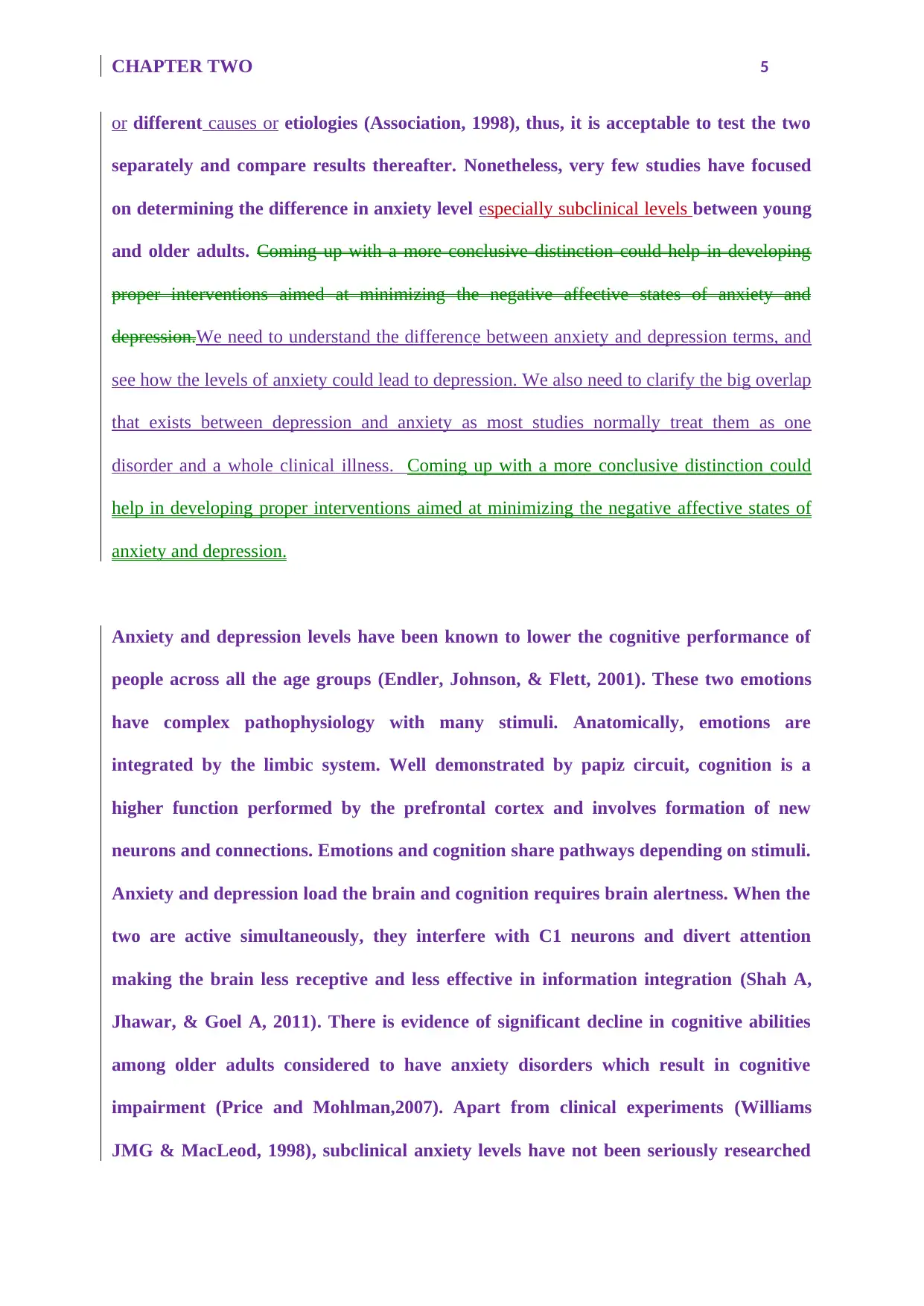
CHAPTER TWO 5
or different causes or etiologies (Association, 1998), thus, it is acceptable to test the two
separately and compare results thereafter. Nonetheless, very few studies have focused
on determining the difference in anxiety level especially subclinical levels between young
and older adults. Coming up with a more conclusive distinction could help in developing
proper interventions aimed at minimizing the negative affective states of anxiety and
depression.We need to understand the difference between anxiety and depression terms, and
see how the levels of anxiety could lead to depression. We also need to clarify the big overlap
that exists between depression and anxiety as most studies normally treat them as one
disorder and a whole clinical illness. Coming up with a more conclusive distinction could
help in developing proper interventions aimed at minimizing the negative affective states of
anxiety and depression.
Anxiety and depression levels have been known to lower the cognitive performance of
people across all the age groups (Endler, Johnson, & Flett, 2001). These two emotions
have complex pathophysiology with many stimuli. Anatomically, emotions are
integrated by the limbic system. Well demonstrated by papiz circuit, cognition is a
higher function performed by the prefrontal cortex and involves formation of new
neurons and connections. Emotions and cognition share pathways depending on stimuli.
Anxiety and depression load the brain and cognition requires brain alertness. When the
two are active simultaneously, they interfere with C1 neurons and divert attention
making the brain less receptive and less effective in information integration (Shah A,
Jhawar, & Goel A, 2011). There is evidence of significant decline in cognitive abilities
among older adults considered to have anxiety disorders which result in cognitive
impairment (Price and Mohlman,2007). Apart from clinical experiments (Williams
JMG & MacLeod, 1998), subclinical anxiety levels have not been seriously researched
or different causes or etiologies (Association, 1998), thus, it is acceptable to test the two
separately and compare results thereafter. Nonetheless, very few studies have focused
on determining the difference in anxiety level especially subclinical levels between young
and older adults. Coming up with a more conclusive distinction could help in developing
proper interventions aimed at minimizing the negative affective states of anxiety and
depression.We need to understand the difference between anxiety and depression terms, and
see how the levels of anxiety could lead to depression. We also need to clarify the big overlap
that exists between depression and anxiety as most studies normally treat them as one
disorder and a whole clinical illness. Coming up with a more conclusive distinction could
help in developing proper interventions aimed at minimizing the negative affective states of
anxiety and depression.
Anxiety and depression levels have been known to lower the cognitive performance of
people across all the age groups (Endler, Johnson, & Flett, 2001). These two emotions
have complex pathophysiology with many stimuli. Anatomically, emotions are
integrated by the limbic system. Well demonstrated by papiz circuit, cognition is a
higher function performed by the prefrontal cortex and involves formation of new
neurons and connections. Emotions and cognition share pathways depending on stimuli.
Anxiety and depression load the brain and cognition requires brain alertness. When the
two are active simultaneously, they interfere with C1 neurons and divert attention
making the brain less receptive and less effective in information integration (Shah A,
Jhawar, & Goel A, 2011). There is evidence of significant decline in cognitive abilities
among older adults considered to have anxiety disorders which result in cognitive
impairment (Price and Mohlman,2007). Apart from clinical experiments (Williams
JMG & MacLeod, 1998), subclinical anxiety levels have not been seriously researched
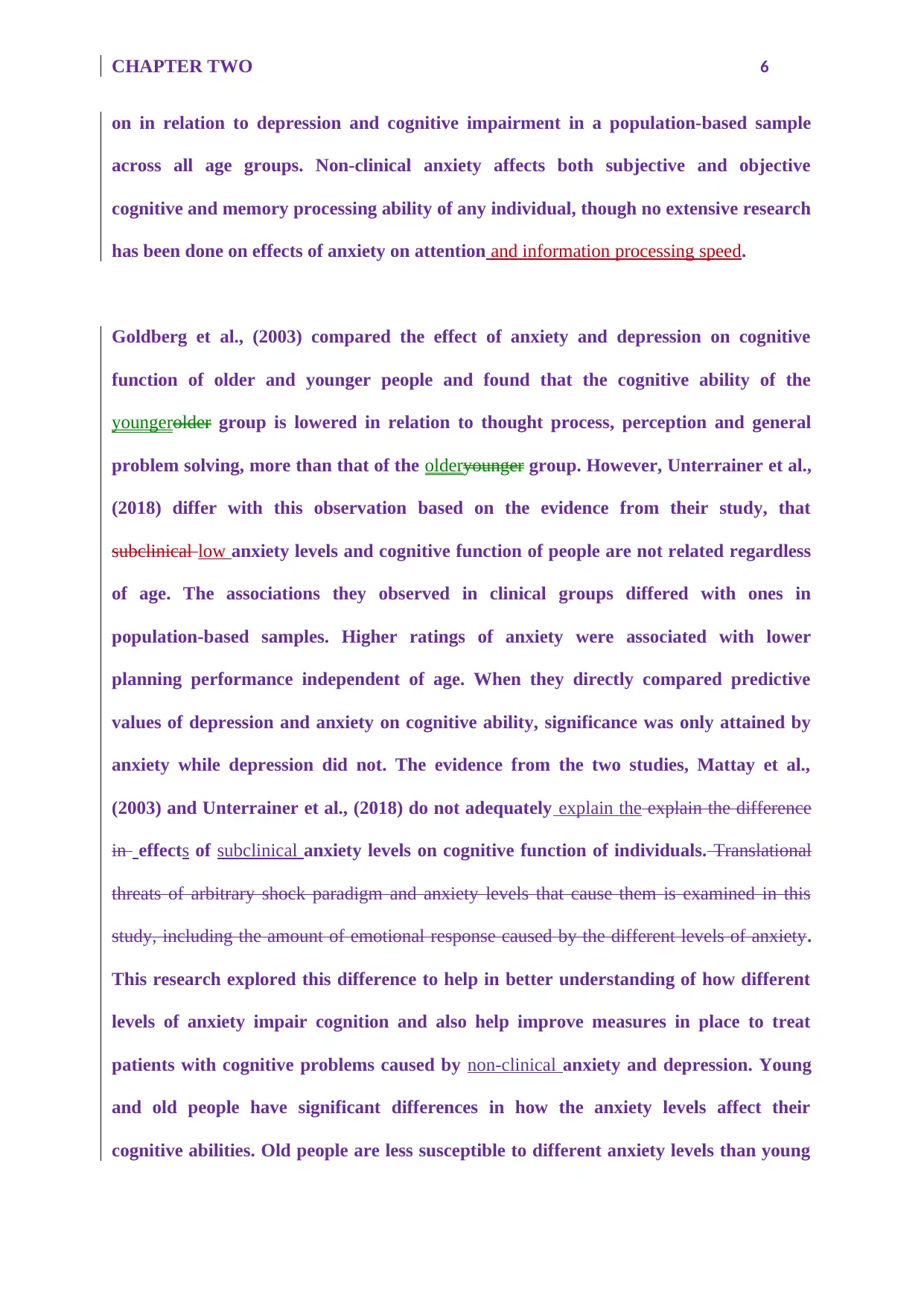
CHAPTER TWO 6
on in relation to depression and cognitive impairment in a population-based sample
across all age groups. Non-clinical anxiety affects both subjective and objective
cognitive and memory processing ability of any individual, though no extensive research
has been done on effects of anxiety on attention and information processing speed.
Goldberg et al., (2003) compared the effect of anxiety and depression on cognitive
function of older and younger people and found that the cognitive ability of the
youngerolder group is lowered in relation to thought process, perception and general
problem solving, more than that of the olderyounger group. However, Unterrainer et al.,
(2018) differ with this observation based on the evidence from their study, that
subclinical low anxiety levels and cognitive function of people are not related regardless
of age. The associations they observed in clinical groups differed with ones in
population-based samples. Higher ratings of anxiety were associated with lower
planning performance independent of age. When they directly compared predictive
values of depression and anxiety on cognitive ability, significance was only attained by
anxiety while depression did not. The evidence from the two studies, Mattay et al.,
(2003) and Unterrainer et al., (2018) do not adequately explain the explain the difference
in effects of subclinical anxiety levels on cognitive function of individuals. Translational
threats of arbitrary shock paradigm and anxiety levels that cause them is examined in this
study, including the amount of emotional response caused by the different levels of anxiety.
This research explored this difference to help in better understanding of how different
levels of anxiety impair cognition and also help improve measures in place to treat
patients with cognitive problems caused by non-clinical anxiety and depression. Young
and old people have significant differences in how the anxiety levels affect their
cognitive abilities. Old people are less susceptible to different anxiety levels than young
on in relation to depression and cognitive impairment in a population-based sample
across all age groups. Non-clinical anxiety affects both subjective and objective
cognitive and memory processing ability of any individual, though no extensive research
has been done on effects of anxiety on attention and information processing speed.
Goldberg et al., (2003) compared the effect of anxiety and depression on cognitive
function of older and younger people and found that the cognitive ability of the
youngerolder group is lowered in relation to thought process, perception and general
problem solving, more than that of the olderyounger group. However, Unterrainer et al.,
(2018) differ with this observation based on the evidence from their study, that
subclinical low anxiety levels and cognitive function of people are not related regardless
of age. The associations they observed in clinical groups differed with ones in
population-based samples. Higher ratings of anxiety were associated with lower
planning performance independent of age. When they directly compared predictive
values of depression and anxiety on cognitive ability, significance was only attained by
anxiety while depression did not. The evidence from the two studies, Mattay et al.,
(2003) and Unterrainer et al., (2018) do not adequately explain the explain the difference
in effects of subclinical anxiety levels on cognitive function of individuals. Translational
threats of arbitrary shock paradigm and anxiety levels that cause them is examined in this
study, including the amount of emotional response caused by the different levels of anxiety.
This research explored this difference to help in better understanding of how different
levels of anxiety impair cognition and also help improve measures in place to treat
patients with cognitive problems caused by non-clinical anxiety and depression. Young
and old people have significant differences in how the anxiety levels affect their
cognitive abilities. Old people are less susceptible to different anxiety levels than young
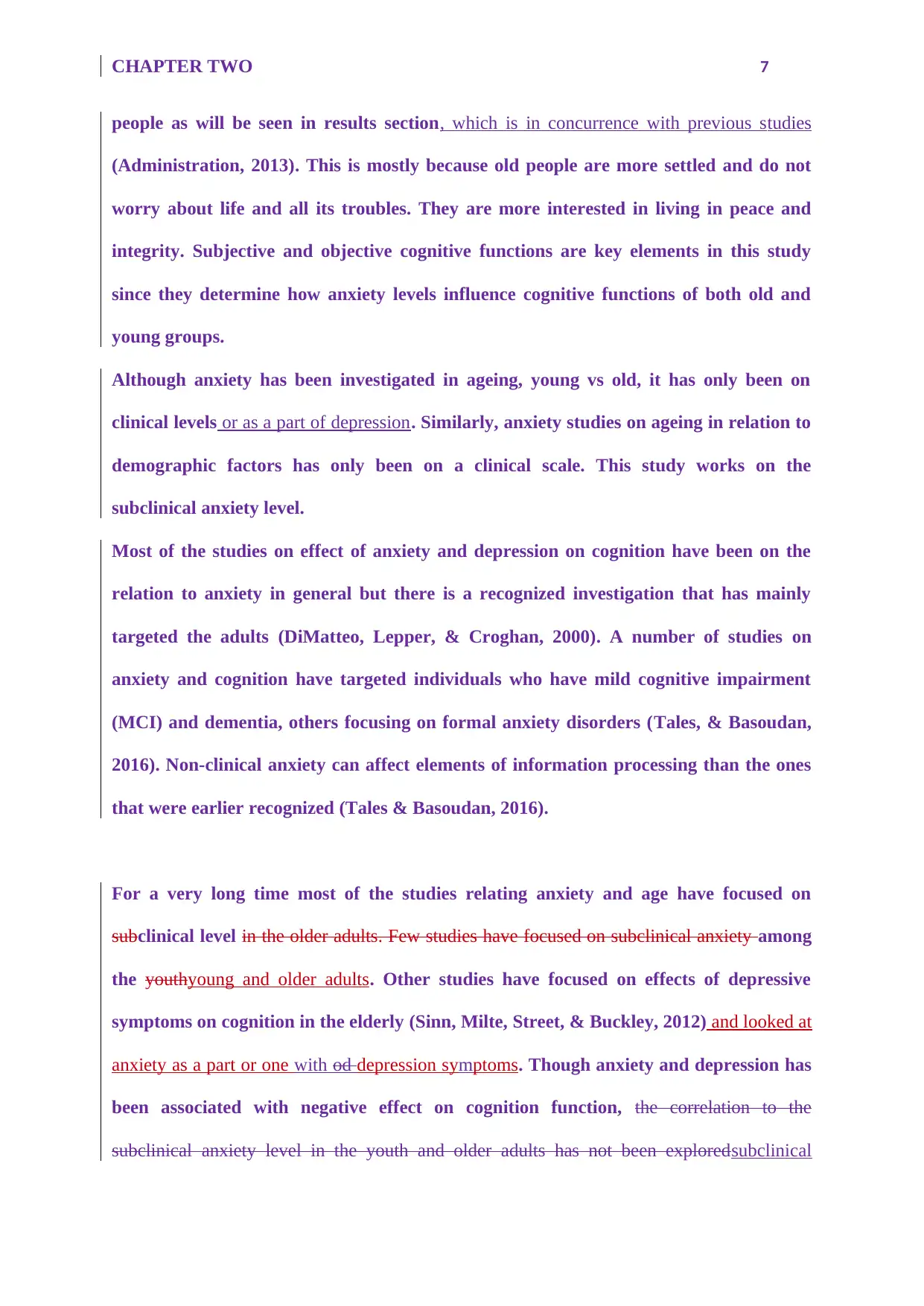
CHAPTER TWO 7
people as will be seen in results section, which is in concurrence with previous studies
(Administration, 2013). This is mostly because old people are more settled and do not
worry about life and all its troubles. They are more interested in living in peace and
integrity. Subjective and objective cognitive functions are key elements in this study
since they determine how anxiety levels influence cognitive functions of both old and
young groups.
Although anxiety has been investigated in ageing, young vs old, it has only been on
clinical levels or as a part of depression. Similarly, anxiety studies on ageing in relation to
demographic factors has only been on a clinical scale. This study works on the
subclinical anxiety level.
Most of the studies on effect of anxiety and depression on cognition have been on the
relation to anxiety in general but there is a recognized investigation that has mainly
targeted the adults (DiMatteo, Lepper, & Croghan, 2000). A number of studies on
anxiety and cognition have targeted individuals who have mild cognitive impairment
(MCI) and dementia, others focusing on formal anxiety disorders (Tales, & Basoudan,
2016). Non-clinical anxiety can affect elements of information processing than the ones
that were earlier recognized (Tales & Basoudan, 2016).
For a very long time most of the studies relating anxiety and age have focused on
subclinical level in the older adults. Few studies have focused on subclinical anxiety among
the youthyoung and older adults. Other studies have focused on effects of depressive
symptoms on cognition in the elderly (Sinn, Milte, Street, & Buckley, 2012) and looked at
anxiety as a part or one with od depression symptoms. Though anxiety and depression has
been associated with negative effect on cognition function, the correlation to the
subclinical anxiety level in the youth and older adults has not been exploredsubclinical
people as will be seen in results section, which is in concurrence with previous studies
(Administration, 2013). This is mostly because old people are more settled and do not
worry about life and all its troubles. They are more interested in living in peace and
integrity. Subjective and objective cognitive functions are key elements in this study
since they determine how anxiety levels influence cognitive functions of both old and
young groups.
Although anxiety has been investigated in ageing, young vs old, it has only been on
clinical levels or as a part of depression. Similarly, anxiety studies on ageing in relation to
demographic factors has only been on a clinical scale. This study works on the
subclinical anxiety level.
Most of the studies on effect of anxiety and depression on cognition have been on the
relation to anxiety in general but there is a recognized investigation that has mainly
targeted the adults (DiMatteo, Lepper, & Croghan, 2000). A number of studies on
anxiety and cognition have targeted individuals who have mild cognitive impairment
(MCI) and dementia, others focusing on formal anxiety disorders (Tales, & Basoudan,
2016). Non-clinical anxiety can affect elements of information processing than the ones
that were earlier recognized (Tales & Basoudan, 2016).
For a very long time most of the studies relating anxiety and age have focused on
subclinical level in the older adults. Few studies have focused on subclinical anxiety among
the youthyoung and older adults. Other studies have focused on effects of depressive
symptoms on cognition in the elderly (Sinn, Milte, Street, & Buckley, 2012) and looked at
anxiety as a part or one with od depression symptoms. Though anxiety and depression has
been associated with negative effect on cognition function, the correlation to the
subclinical anxiety level in the youth and older adults has not been exploredsubclinical
Paraphrase This Document
Need a fresh take? Get an instant paraphrase of this document with our AI Paraphraser
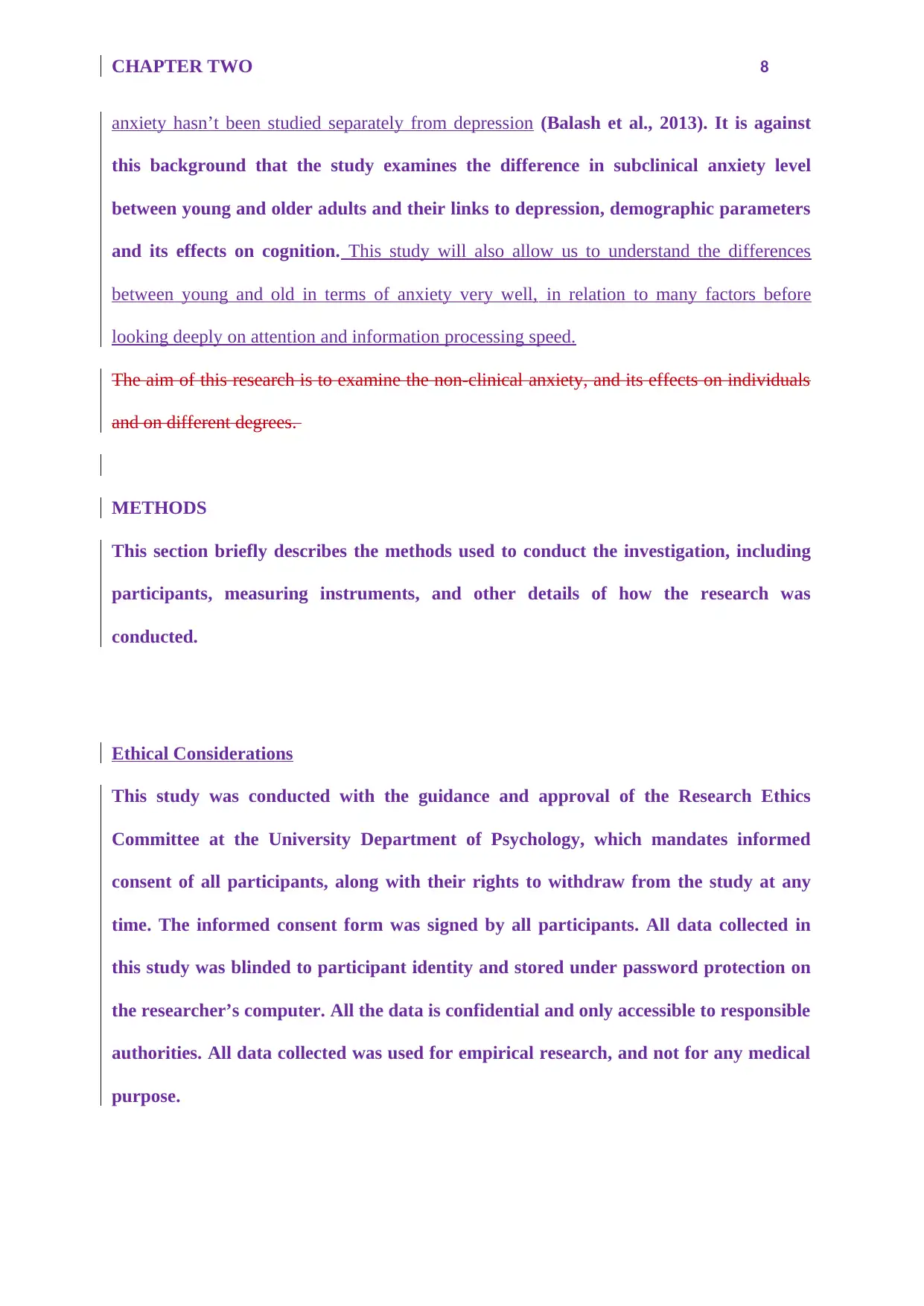
CHAPTER TWO 8
anxiety hasn’t been studied separately from depression (Balash et al., 2013). It is against
this background that the study examines the difference in subclinical anxiety level
between young and older adults and their links to depression, demographic parameters
and its effects on cognition. This study will also allow us to understand the differences
between young and old in terms of anxiety very well, in relation to many factors before
looking deeply on attention and information processing speed.
The aim of this research is to examine the non-clinical anxiety, and its effects on individuals
and on different degrees.
METHODS
This section briefly describes the methods used to conduct the investigation, including
participants, measuring instruments, and other details of how the research was
conducted.
Ethical Considerations
This study was conducted with the guidance and approval of the Research Ethics
Committee at the University Department of Psychology, which mandates informed
consent of all participants, along with their rights to withdraw from the study at any
time. The informed consent form was signed by all participants. All data collected in
this study was blinded to participant identity and stored under password protection on
the researcher’s computer. All the data is confidential and only accessible to responsible
authorities. All data collected was used for empirical research, and not for any medical
purpose.
anxiety hasn’t been studied separately from depression (Balash et al., 2013). It is against
this background that the study examines the difference in subclinical anxiety level
between young and older adults and their links to depression, demographic parameters
and its effects on cognition. This study will also allow us to understand the differences
between young and old in terms of anxiety very well, in relation to many factors before
looking deeply on attention and information processing speed.
The aim of this research is to examine the non-clinical anxiety, and its effects on individuals
and on different degrees.
METHODS
This section briefly describes the methods used to conduct the investigation, including
participants, measuring instruments, and other details of how the research was
conducted.
Ethical Considerations
This study was conducted with the guidance and approval of the Research Ethics
Committee at the University Department of Psychology, which mandates informed
consent of all participants, along with their rights to withdraw from the study at any
time. The informed consent form was signed by all participants. All data collected in
this study was blinded to participant identity and stored under password protection on
the researcher’s computer. All the data is confidential and only accessible to responsible
authorities. All data collected was used for empirical research, and not for any medical
purpose.
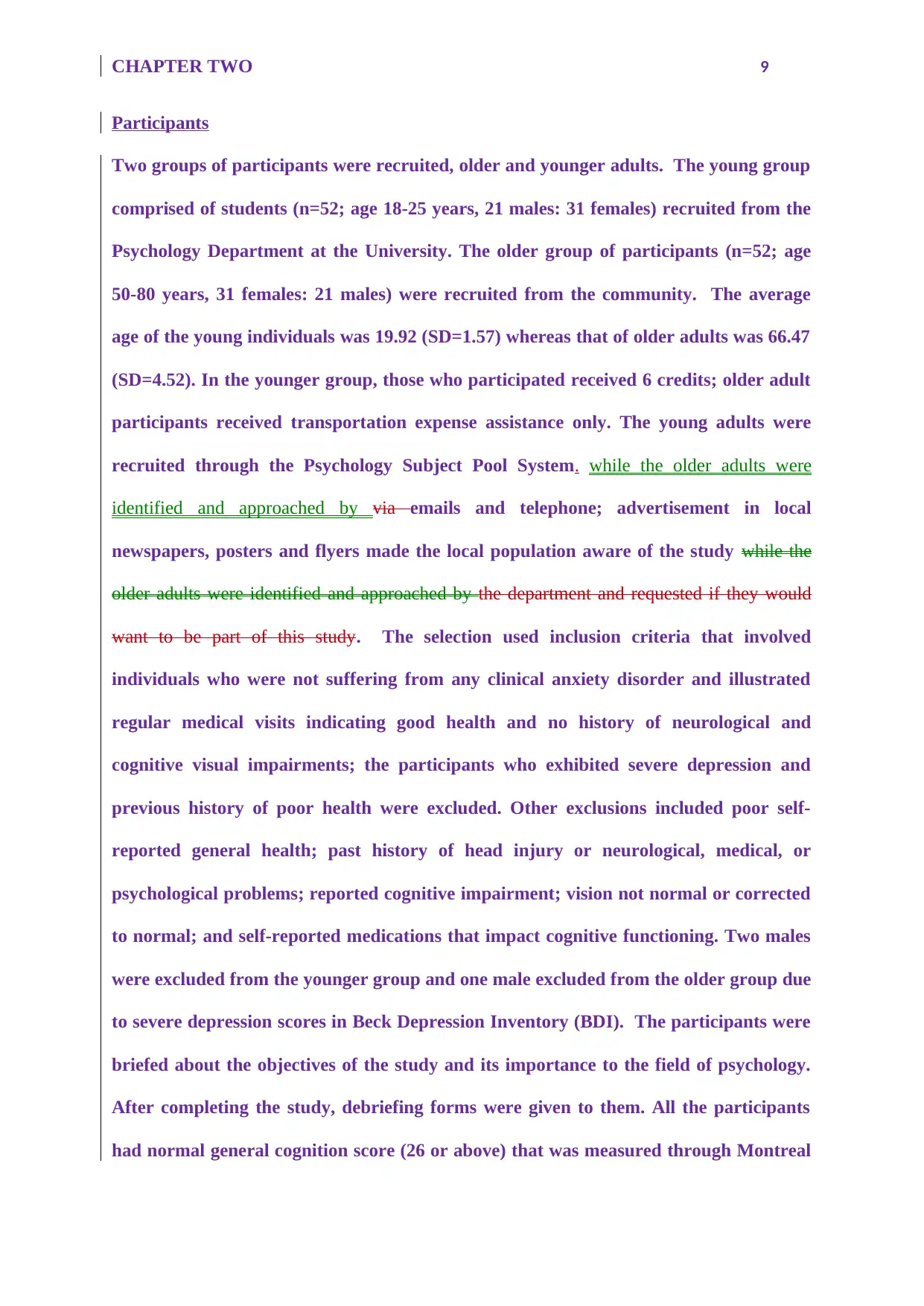
CHAPTER TWO 9
Participants
Two groups of participants were recruited, older and younger adults. The young group
comprised of students (n=52; age 18-25 years, 21 males: 31 females) recruited from the
Psychology Department at the University. The older group of participants (n=52; age
50-80 years, 31 females: 21 males) were recruited from the community. The average
age of the young individuals was 19.92 (SD=1.57) whereas that of older adults was 66.47
(SD=4.52). In the younger group, those who participated received 6 credits; older adult
participants received transportation expense assistance only. The young adults were
recruited through the Psychology Subject Pool System. while the older adults were
identified and approached by via emails and telephone; advertisement in local
newspapers, posters and flyers made the local population aware of the study while the
older adults were identified and approached by the department and requested if they would
want to be part of this study. The selection used inclusion criteria that involved
individuals who were not suffering from any clinical anxiety disorder and illustrated
regular medical visits indicating good health and no history of neurological and
cognitive visual impairments; the participants who exhibited severe depression and
previous history of poor health were excluded. Other exclusions included poor self-
reported general health; past history of head injury or neurological, medical, or
psychological problems; reported cognitive impairment; vision not normal or corrected
to normal; and self-reported medications that impact cognitive functioning. Two males
were excluded from the younger group and one male excluded from the older group due
to severe depression scores in Beck Depression Inventory (BDI). The participants were
briefed about the objectives of the study and its importance to the field of psychology.
After completing the study, debriefing forms were given to them. All the participants
had normal general cognition score (26 or above) that was measured through Montreal
Participants
Two groups of participants were recruited, older and younger adults. The young group
comprised of students (n=52; age 18-25 years, 21 males: 31 females) recruited from the
Psychology Department at the University. The older group of participants (n=52; age
50-80 years, 31 females: 21 males) were recruited from the community. The average
age of the young individuals was 19.92 (SD=1.57) whereas that of older adults was 66.47
(SD=4.52). In the younger group, those who participated received 6 credits; older adult
participants received transportation expense assistance only. The young adults were
recruited through the Psychology Subject Pool System. while the older adults were
identified and approached by via emails and telephone; advertisement in local
newspapers, posters and flyers made the local population aware of the study while the
older adults were identified and approached by the department and requested if they would
want to be part of this study. The selection used inclusion criteria that involved
individuals who were not suffering from any clinical anxiety disorder and illustrated
regular medical visits indicating good health and no history of neurological and
cognitive visual impairments; the participants who exhibited severe depression and
previous history of poor health were excluded. Other exclusions included poor self-
reported general health; past history of head injury or neurological, medical, or
psychological problems; reported cognitive impairment; vision not normal or corrected
to normal; and self-reported medications that impact cognitive functioning. Two males
were excluded from the younger group and one male excluded from the older group due
to severe depression scores in Beck Depression Inventory (BDI). The participants were
briefed about the objectives of the study and its importance to the field of psychology.
After completing the study, debriefing forms were given to them. All the participants
had normal general cognition score (26 or above) that was measured through Montreal

CHAPTER TWO 10
Cognitive Assessment (MoCA). This approach detects objective cognitive functioning
and mild cognitive impairment and assesses such cognitive domains as attention,
concentration, executive functions, memory, language, visuospatial skills, abstraction,
calculation, and orientation (Julayonont et al., 2013). The instrument consists of a
variety of verbal and pencil-and-paper tasks such as drawing a clock, copying a
diagram of a cube, and doing delayed verbal recall of a list of words. Scoring ranges
from 0 to 30, with higher scores indicating less cognitive impairment (Julayanont and &
Nasreddine, 2017).
Data Collection
The demographic data collected included age, gender, years of education, handedness
and vision. Some of the instruments used included consent form, information sheet and
debriefing form, questionnaire as well as demographics form, all found in Appendix A.
Table 1: Participants’ Normality Test- (Demographic)………Demographic Factors of
Participants……………………..
Mean (SD) Older adults Young group Old Males Old Females Young Males Young Females
Years of education 14.53 (4.320) 14.722 (.698) 14.70 (5.141) 14.42 (3.804) 14.57 (2.226) 14.82 (3.007)
Handedness 1.08 (.269) 1.17 (.430) 1.15 (.366) 1.03 (.177) 1.24 (.436) 1.13 (.428)
Vision 1.33 (.834) 3.85 (1.808) 1.20 (.696) 1.41 (.911) 3.71 (1.875) 3.94 (1.788)
Instruments
A copy of the demographics form, questionnaire, information sheet and debriefing form are
in Appendix A. Participants completed the Beck Anxiety Inventory (BAI) (Steer & Beck
A. T, 1997) ref., the State Trait Anxiety Inventory (STAI) in full (Spielberger, 2010)ref.,
Cognitive Assessment (MoCA). This approach detects objective cognitive functioning
and mild cognitive impairment and assesses such cognitive domains as attention,
concentration, executive functions, memory, language, visuospatial skills, abstraction,
calculation, and orientation (Julayonont et al., 2013). The instrument consists of a
variety of verbal and pencil-and-paper tasks such as drawing a clock, copying a
diagram of a cube, and doing delayed verbal recall of a list of words. Scoring ranges
from 0 to 30, with higher scores indicating less cognitive impairment (Julayanont and &
Nasreddine, 2017).
Data Collection
The demographic data collected included age, gender, years of education, handedness
and vision. Some of the instruments used included consent form, information sheet and
debriefing form, questionnaire as well as demographics form, all found in Appendix A.
Table 1: Participants’ Normality Test- (Demographic)………Demographic Factors of
Participants……………………..
Mean (SD) Older adults Young group Old Males Old Females Young Males Young Females
Years of education 14.53 (4.320) 14.722 (.698) 14.70 (5.141) 14.42 (3.804) 14.57 (2.226) 14.82 (3.007)
Handedness 1.08 (.269) 1.17 (.430) 1.15 (.366) 1.03 (.177) 1.24 (.436) 1.13 (.428)
Vision 1.33 (.834) 3.85 (1.808) 1.20 (.696) 1.41 (.911) 3.71 (1.875) 3.94 (1.788)
Instruments
A copy of the demographics form, questionnaire, information sheet and debriefing form are
in Appendix A. Participants completed the Beck Anxiety Inventory (BAI) (Steer & Beck
A. T, 1997) ref., the State Trait Anxiety Inventory (STAI) in full (Spielberger, 2010)ref.,
Secure Best Marks with AI Grader
Need help grading? Try our AI Grader for instant feedback on your assignments.
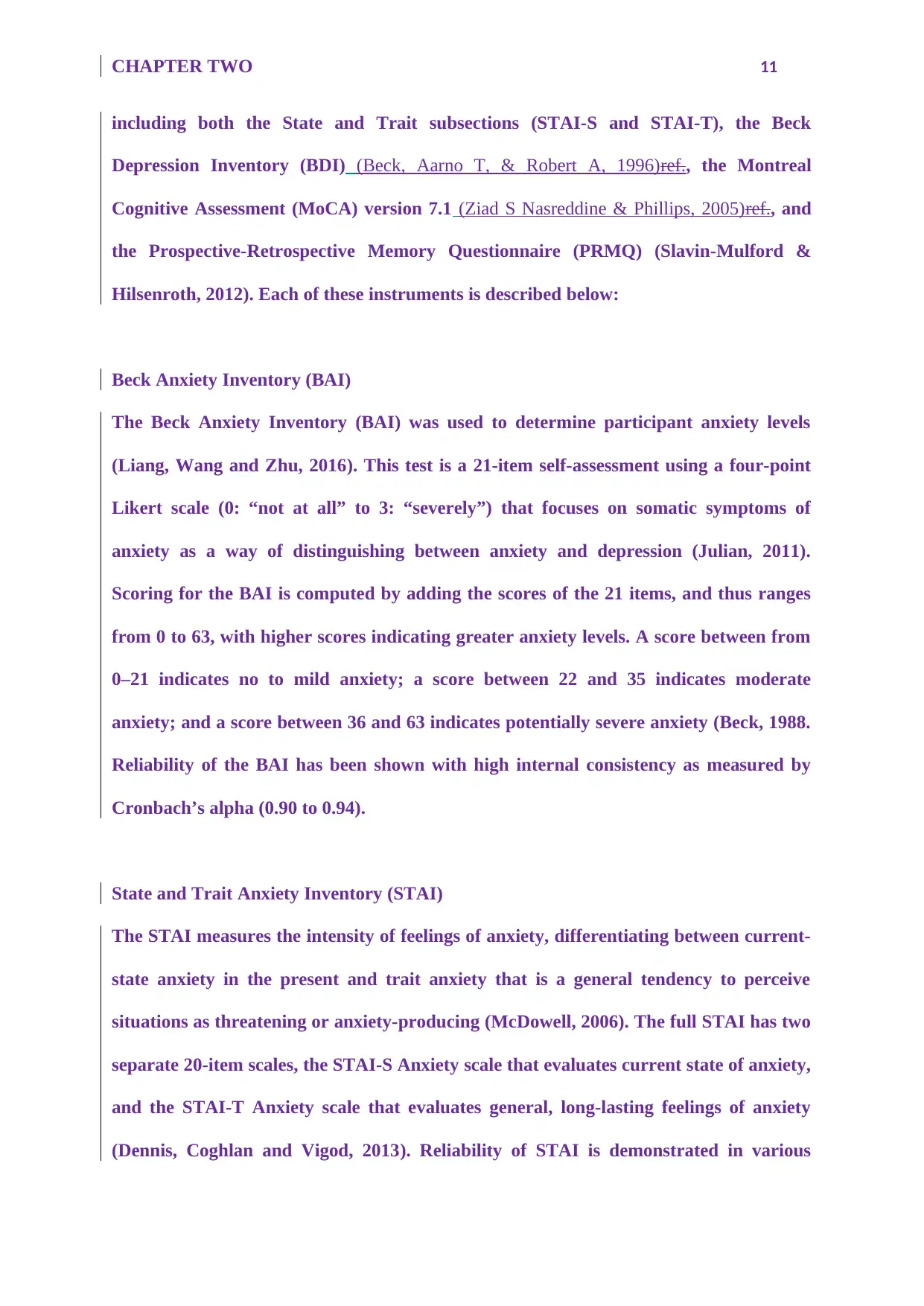
CHAPTER TWO 11
including both the State and Trait subsections (STAI-S and STAI-T), the Beck
Depression Inventory (BDI) (Beck, Aarno T, & Robert A, 1996)ref., the Montreal
Cognitive Assessment (MoCA) version 7.1 (Ziad S Nasreddine & Phillips, 2005)ref., and
the Prospective-Retrospective Memory Questionnaire (PRMQ) (Slavin-Mulford &
Hilsenroth, 2012). Each of these instruments is described below:
Beck Anxiety Inventory (BAI)
The Beck Anxiety Inventory (BAI) was used to determine participant anxiety levels
(Liang, Wang and Zhu, 2016). This test is a 21-item self-assessment using a four-point
Likert scale (0: “not at all” to 3: “severely”) that focuses on somatic symptoms of
anxiety as a way of distinguishing between anxiety and depression (Julian, 2011).
Scoring for the BAI is computed by adding the scores of the 21 items, and thus ranges
from 0 to 63, with higher scores indicating greater anxiety levels. A score between from
0–21 indicates no to mild anxiety; a score between 22 and 35 indicates moderate
anxiety; and a score between 36 and 63 indicates potentially severe anxiety (Beck, 1988.
Reliability of the BAI has been shown with high internal consistency as measured by
Cronbach’s alpha (0.90 to 0.94).
State and Trait Anxiety Inventory (STAI)
The STAI measures the intensity of feelings of anxiety, differentiating between current-
state anxiety in the present and trait anxiety that is a general tendency to perceive
situations as threatening or anxiety-producing (McDowell, 2006). The full STAI has two
separate 20-item scales, the STAI-S Anxiety scale that evaluates current state of anxiety,
and the STAI-T Anxiety scale that evaluates general, long-lasting feelings of anxiety
(Dennis, Coghlan and Vigod, 2013). Reliability of STAI is demonstrated in various
including both the State and Trait subsections (STAI-S and STAI-T), the Beck
Depression Inventory (BDI) (Beck, Aarno T, & Robert A, 1996)ref., the Montreal
Cognitive Assessment (MoCA) version 7.1 (Ziad S Nasreddine & Phillips, 2005)ref., and
the Prospective-Retrospective Memory Questionnaire (PRMQ) (Slavin-Mulford &
Hilsenroth, 2012). Each of these instruments is described below:
Beck Anxiety Inventory (BAI)
The Beck Anxiety Inventory (BAI) was used to determine participant anxiety levels
(Liang, Wang and Zhu, 2016). This test is a 21-item self-assessment using a four-point
Likert scale (0: “not at all” to 3: “severely”) that focuses on somatic symptoms of
anxiety as a way of distinguishing between anxiety and depression (Julian, 2011).
Scoring for the BAI is computed by adding the scores of the 21 items, and thus ranges
from 0 to 63, with higher scores indicating greater anxiety levels. A score between from
0–21 indicates no to mild anxiety; a score between 22 and 35 indicates moderate
anxiety; and a score between 36 and 63 indicates potentially severe anxiety (Beck, 1988.
Reliability of the BAI has been shown with high internal consistency as measured by
Cronbach’s alpha (0.90 to 0.94).
State and Trait Anxiety Inventory (STAI)
The STAI measures the intensity of feelings of anxiety, differentiating between current-
state anxiety in the present and trait anxiety that is a general tendency to perceive
situations as threatening or anxiety-producing (McDowell, 2006). The full STAI has two
separate 20-item scales, the STAI-S Anxiety scale that evaluates current state of anxiety,
and the STAI-T Anxiety scale that evaluates general, long-lasting feelings of anxiety
(Dennis, Coghlan and Vigod, 2013). Reliability of STAI is demonstrated in various
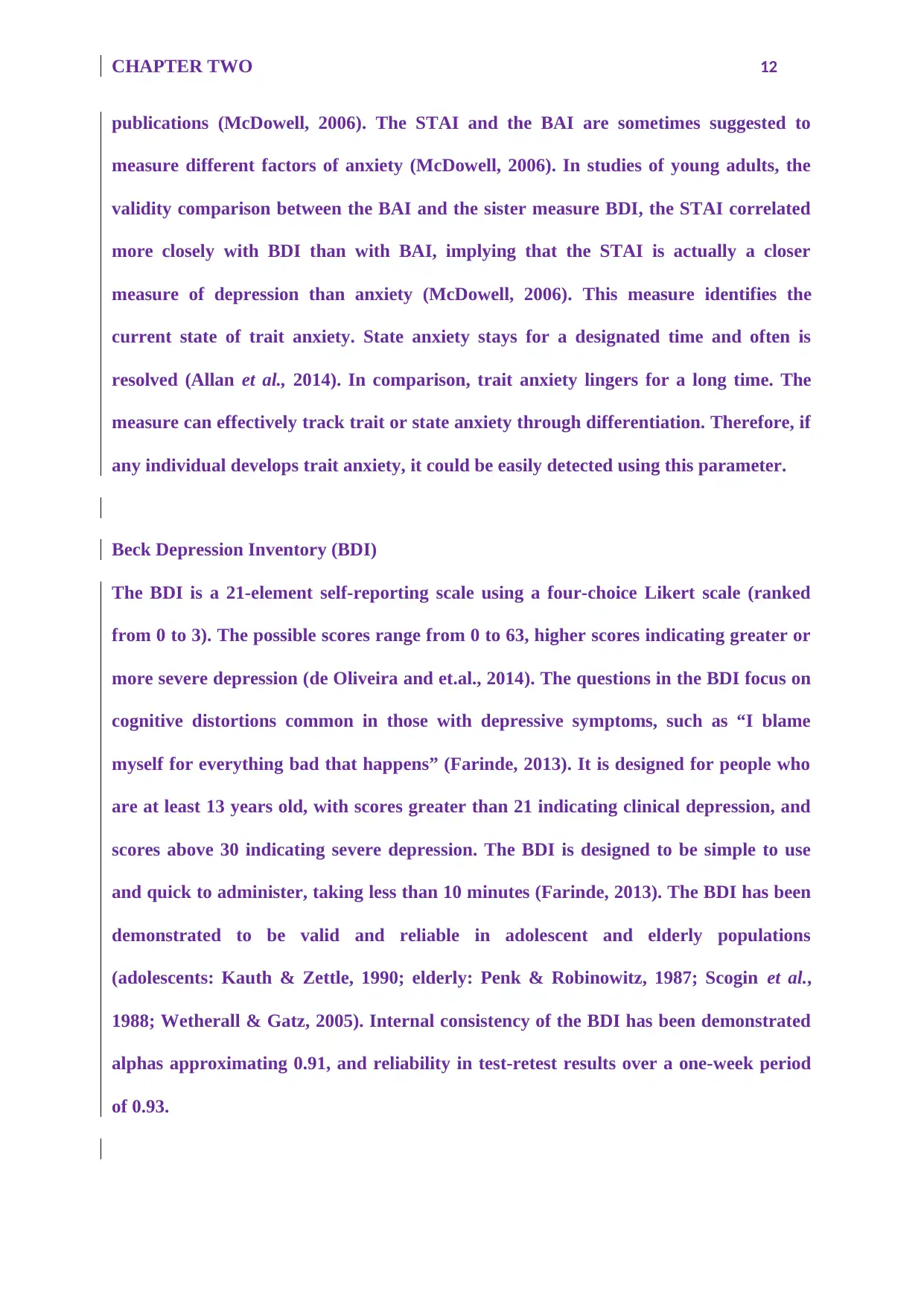
CHAPTER TWO 12
publications (McDowell, 2006). The STAI and the BAI are sometimes suggested to
measure different factors of anxiety (McDowell, 2006). In studies of young adults, the
validity comparison between the BAI and the sister measure BDI, the STAI correlated
more closely with BDI than with BAI, implying that the STAI is actually a closer
measure of depression than anxiety (McDowell, 2006). This measure identifies the
current state of trait anxiety. State anxiety stays for a designated time and often is
resolved (Allan et al., 2014). In comparison, trait anxiety lingers for a long time. The
measure can effectively track trait or state anxiety through differentiation. Therefore, if
any individual develops trait anxiety, it could be easily detected using this parameter.
Beck Depression Inventory (BDI)
The BDI is a 21-element self-reporting scale using a four-choice Likert scale (ranked
from 0 to 3). The possible scores range from 0 to 63, higher scores indicating greater or
more severe depression (de Oliveira and et.al., 2014). The questions in the BDI focus on
cognitive distortions common in those with depressive symptoms, such as “I blame
myself for everything bad that happens” (Farinde, 2013). It is designed for people who
are at least 13 years old, with scores greater than 21 indicating clinical depression, and
scores above 30 indicating severe depression. The BDI is designed to be simple to use
and quick to administer, taking less than 10 minutes (Farinde, 2013). The BDI has been
demonstrated to be valid and reliable in adolescent and elderly populations
(adolescents: Kauth & Zettle, 1990; elderly: Penk & Robinowitz, 1987; Scogin et al.,
1988; Wetherall & Gatz, 2005). Internal consistency of the BDI has been demonstrated
alphas approximating 0.91, and reliability in test-retest results over a one-week period
of 0.93.
publications (McDowell, 2006). The STAI and the BAI are sometimes suggested to
measure different factors of anxiety (McDowell, 2006). In studies of young adults, the
validity comparison between the BAI and the sister measure BDI, the STAI correlated
more closely with BDI than with BAI, implying that the STAI is actually a closer
measure of depression than anxiety (McDowell, 2006). This measure identifies the
current state of trait anxiety. State anxiety stays for a designated time and often is
resolved (Allan et al., 2014). In comparison, trait anxiety lingers for a long time. The
measure can effectively track trait or state anxiety through differentiation. Therefore, if
any individual develops trait anxiety, it could be easily detected using this parameter.
Beck Depression Inventory (BDI)
The BDI is a 21-element self-reporting scale using a four-choice Likert scale (ranked
from 0 to 3). The possible scores range from 0 to 63, higher scores indicating greater or
more severe depression (de Oliveira and et.al., 2014). The questions in the BDI focus on
cognitive distortions common in those with depressive symptoms, such as “I blame
myself for everything bad that happens” (Farinde, 2013). It is designed for people who
are at least 13 years old, with scores greater than 21 indicating clinical depression, and
scores above 30 indicating severe depression. The BDI is designed to be simple to use
and quick to administer, taking less than 10 minutes (Farinde, 2013). The BDI has been
demonstrated to be valid and reliable in adolescent and elderly populations
(adolescents: Kauth & Zettle, 1990; elderly: Penk & Robinowitz, 1987; Scogin et al.,
1988; Wetherall & Gatz, 2005). Internal consistency of the BDI has been demonstrated
alphas approximating 0.91, and reliability in test-retest results over a one-week period
of 0.93.
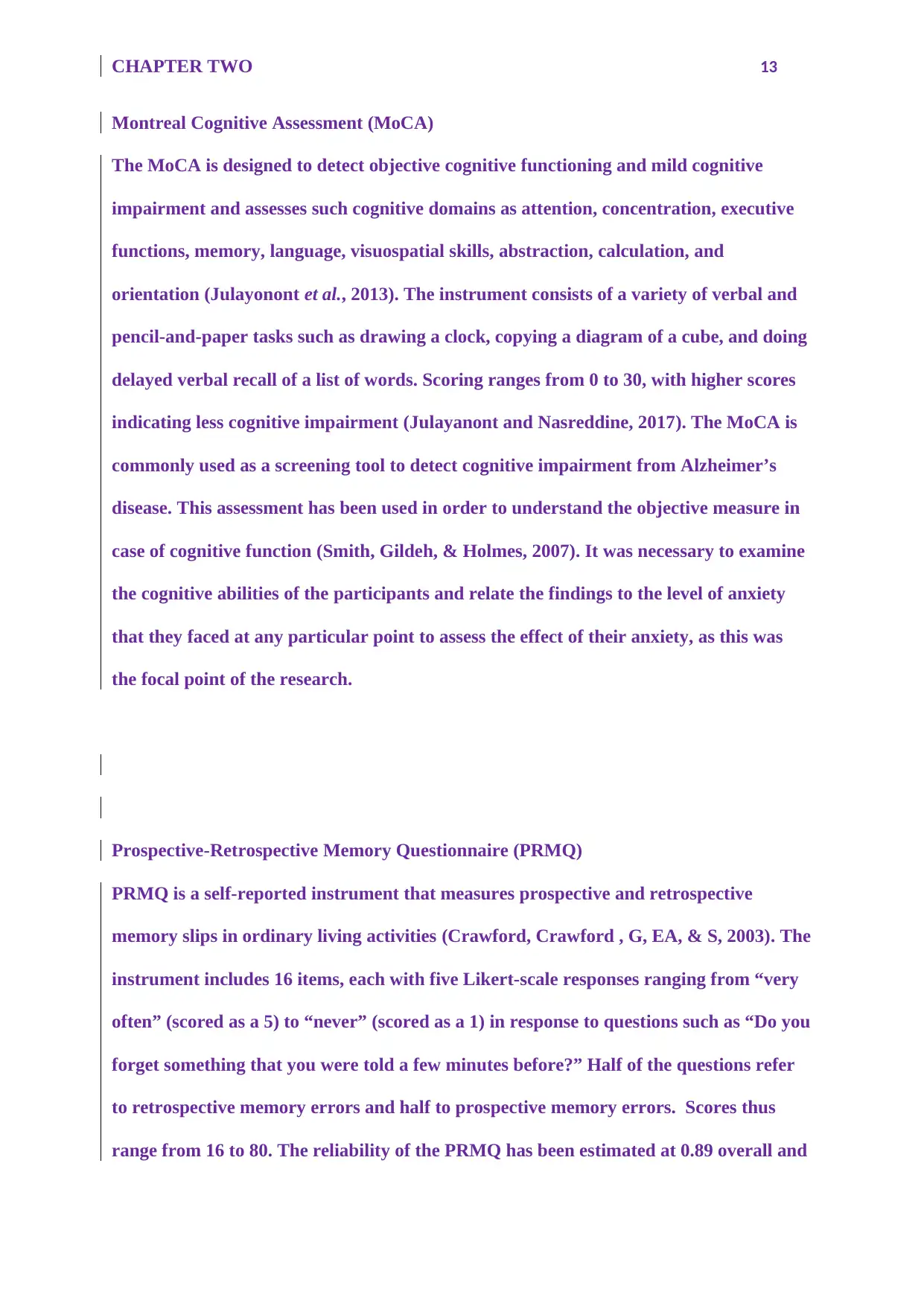
CHAPTER TWO 13
Montreal Cognitive Assessment (MoCA)
The MoCA is designed to detect objective cognitive functioning and mild cognitive
impairment and assesses such cognitive domains as attention, concentration, executive
functions, memory, language, visuospatial skills, abstraction, calculation, and
orientation (Julayonont et al., 2013). The instrument consists of a variety of verbal and
pencil-and-paper tasks such as drawing a clock, copying a diagram of a cube, and doing
delayed verbal recall of a list of words. Scoring ranges from 0 to 30, with higher scores
indicating less cognitive impairment (Julayanont and Nasreddine, 2017). The MoCA is
commonly used as a screening tool to detect cognitive impairment from Alzheimer’s
disease. This assessment has been used in order to understand the objective measure in
case of cognitive function (Smith, Gildeh, & Holmes, 2007). It was necessary to examine
the cognitive abilities of the participants and relate the findings to the level of anxiety
that they faced at any particular point to assess the effect of their anxiety, as this was
the focal point of the research.
Prospective-Retrospective Memory Questionnaire (PRMQ)
PRMQ is a self-reported instrument that measures prospective and retrospective
memory slips in ordinary living activities (Crawford, Crawford , G, EA, & S, 2003). The
instrument includes 16 items, each with five Likert-scale responses ranging from “very
often” (scored as a 5) to “never” (scored as a 1) in response to questions such as “Do you
forget something that you were told a few minutes before?” Half of the questions refer
to retrospective memory errors and half to prospective memory errors. Scores thus
range from 16 to 80. The reliability of the PRMQ has been estimated at 0.89 overall and
Montreal Cognitive Assessment (MoCA)
The MoCA is designed to detect objective cognitive functioning and mild cognitive
impairment and assesses such cognitive domains as attention, concentration, executive
functions, memory, language, visuospatial skills, abstraction, calculation, and
orientation (Julayonont et al., 2013). The instrument consists of a variety of verbal and
pencil-and-paper tasks such as drawing a clock, copying a diagram of a cube, and doing
delayed verbal recall of a list of words. Scoring ranges from 0 to 30, with higher scores
indicating less cognitive impairment (Julayanont and Nasreddine, 2017). The MoCA is
commonly used as a screening tool to detect cognitive impairment from Alzheimer’s
disease. This assessment has been used in order to understand the objective measure in
case of cognitive function (Smith, Gildeh, & Holmes, 2007). It was necessary to examine
the cognitive abilities of the participants and relate the findings to the level of anxiety
that they faced at any particular point to assess the effect of their anxiety, as this was
the focal point of the research.
Prospective-Retrospective Memory Questionnaire (PRMQ)
PRMQ is a self-reported instrument that measures prospective and retrospective
memory slips in ordinary living activities (Crawford, Crawford , G, EA, & S, 2003). The
instrument includes 16 items, each with five Likert-scale responses ranging from “very
often” (scored as a 5) to “never” (scored as a 1) in response to questions such as “Do you
forget something that you were told a few minutes before?” Half of the questions refer
to retrospective memory errors and half to prospective memory errors. Scores thus
range from 16 to 80. The reliability of the PRMQ has been estimated at 0.89 overall and
Paraphrase This Document
Need a fresh take? Get an instant paraphrase of this document with our AI Paraphraser
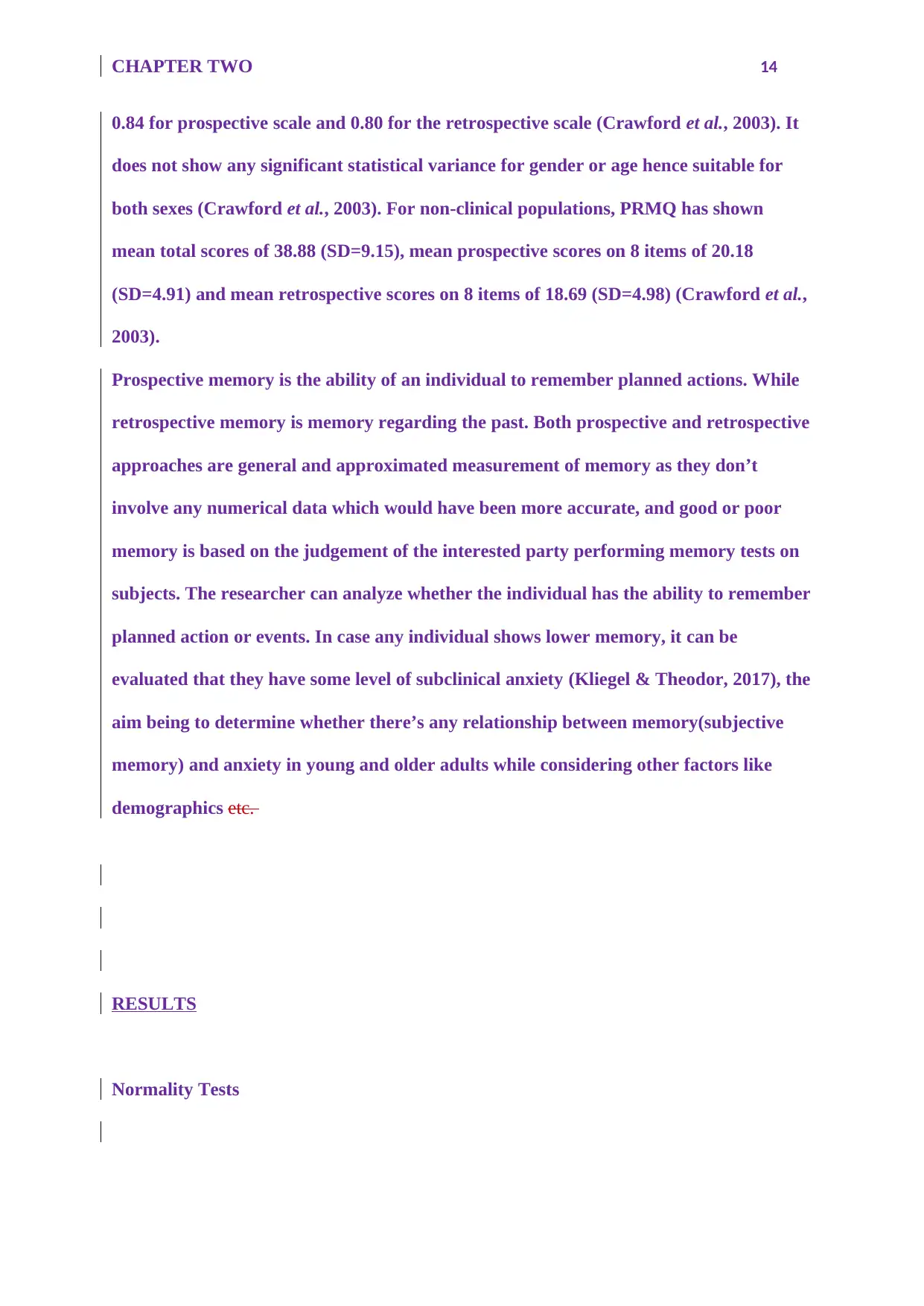
CHAPTER TWO 14
0.84 for prospective scale and 0.80 for the retrospective scale (Crawford et al., 2003). It
does not show any significant statistical variance for gender or age hence suitable for
both sexes (Crawford et al., 2003). For non-clinical populations, PRMQ has shown
mean total scores of 38.88 (SD=9.15), mean prospective scores on 8 items of 20.18
(SD=4.91) and mean retrospective scores on 8 items of 18.69 (SD=4.98) (Crawford et al.,
2003).
Prospective memory is the ability of an individual to remember planned actions. While
retrospective memory is memory regarding the past. Both prospective and retrospective
approaches are general and approximated measurement of memory as they don’t
involve any numerical data which would have been more accurate, and good or poor
memory is based on the judgement of the interested party performing memory tests on
subjects. The researcher can analyze whether the individual has the ability to remember
planned action or events. In case any individual shows lower memory, it can be
evaluated that they have some level of subclinical anxiety (Kliegel & Theodor, 2017), the
aim being to determine whether there’s any relationship between memory(subjective
memory) and anxiety in young and older adults while considering other factors like
demographics etc.
RESULTS
Normality Tests
0.84 for prospective scale and 0.80 for the retrospective scale (Crawford et al., 2003). It
does not show any significant statistical variance for gender or age hence suitable for
both sexes (Crawford et al., 2003). For non-clinical populations, PRMQ has shown
mean total scores of 38.88 (SD=9.15), mean prospective scores on 8 items of 20.18
(SD=4.91) and mean retrospective scores on 8 items of 18.69 (SD=4.98) (Crawford et al.,
2003).
Prospective memory is the ability of an individual to remember planned actions. While
retrospective memory is memory regarding the past. Both prospective and retrospective
approaches are general and approximated measurement of memory as they don’t
involve any numerical data which would have been more accurate, and good or poor
memory is based on the judgement of the interested party performing memory tests on
subjects. The researcher can analyze whether the individual has the ability to remember
planned action or events. In case any individual shows lower memory, it can be
evaluated that they have some level of subclinical anxiety (Kliegel & Theodor, 2017), the
aim being to determine whether there’s any relationship between memory(subjective
memory) and anxiety in young and older adults while considering other factors like
demographics etc.
RESULTS
Normality Tests
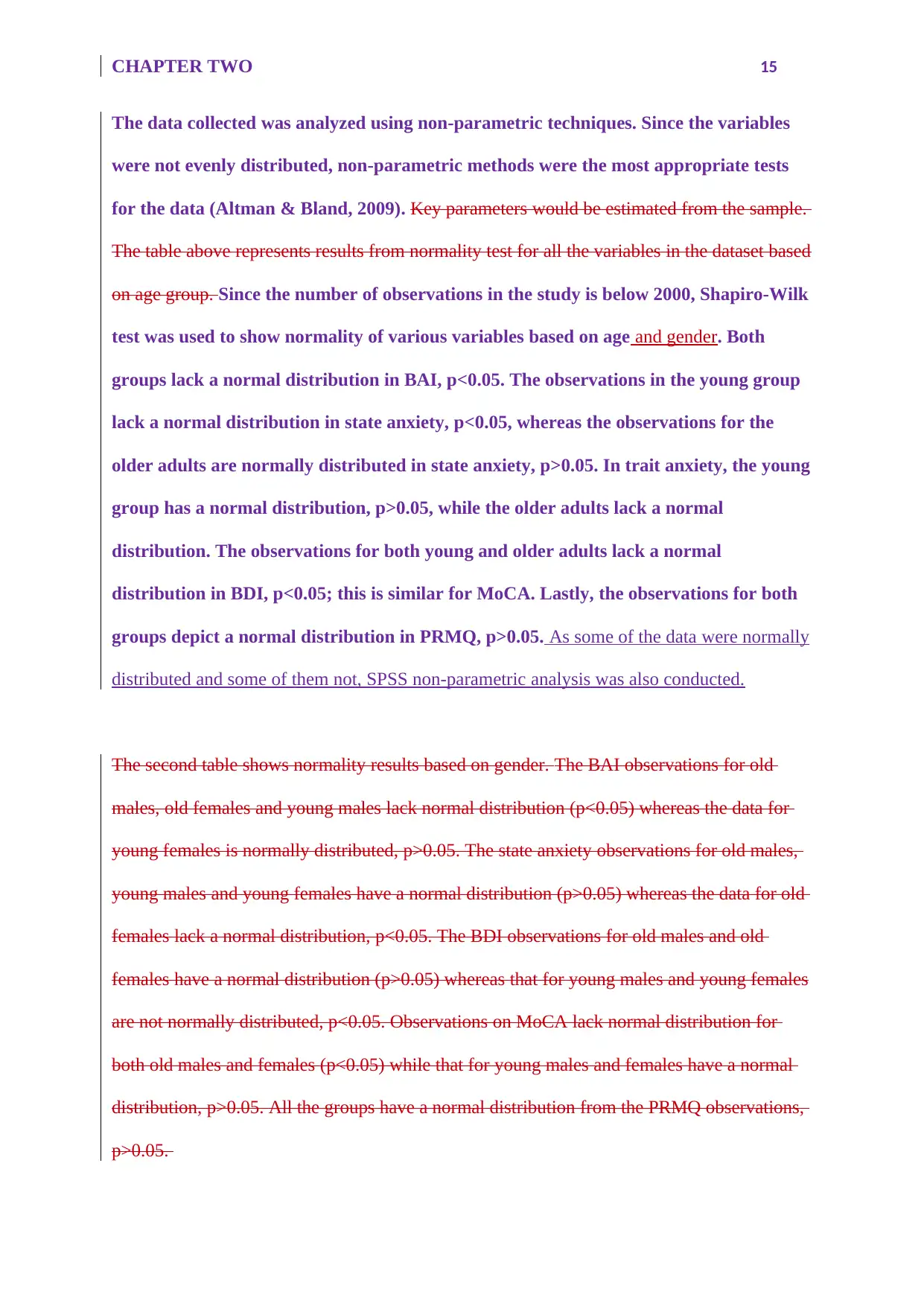
CHAPTER TWO 15
The data collected was analyzed using non-parametric techniques. Since the variables
were not evenly distributed, non-parametric methods were the most appropriate tests
for the data (Altman & Bland, 2009). Key parameters would be estimated from the sample.
The table above represents results from normality test for all the variables in the dataset based
on age group. Since the number of observations in the study is below 2000, Shapiro-Wilk
test was used to show normality of various variables based on age and gender. Both
groups lack a normal distribution in BAI, p<0.05. The observations in the young group
lack a normal distribution in state anxiety, p<0.05, whereas the observations for the
older adults are normally distributed in state anxiety, p>0.05. In trait anxiety, the young
group has a normal distribution, p>0.05, while the older adults lack a normal
distribution. The observations for both young and older adults lack a normal
distribution in BDI, p<0.05; this is similar for MoCA. Lastly, the observations for both
groups depict a normal distribution in PRMQ, p>0.05. As some of the data were normally
distributed and some of them not, SPSS non-parametric analysis was also conducted.
The second table shows normality results based on gender. The BAI observations for old
males, old females and young males lack normal distribution (p<0.05) whereas the data for
young females is normally distributed, p>0.05. The state anxiety observations for old males,
young males and young females have a normal distribution (p>0.05) whereas the data for old
females lack a normal distribution, p<0.05. The BDI observations for old males and old
females have a normal distribution (p>0.05) whereas that for young males and young females
are not normally distributed, p<0.05. Observations on MoCA lack normal distribution for
both old males and females (p<0.05) while that for young males and females have a normal
distribution, p>0.05. All the groups have a normal distribution from the PRMQ observations,
p>0.05.
The data collected was analyzed using non-parametric techniques. Since the variables
were not evenly distributed, non-parametric methods were the most appropriate tests
for the data (Altman & Bland, 2009). Key parameters would be estimated from the sample.
The table above represents results from normality test for all the variables in the dataset based
on age group. Since the number of observations in the study is below 2000, Shapiro-Wilk
test was used to show normality of various variables based on age and gender. Both
groups lack a normal distribution in BAI, p<0.05. The observations in the young group
lack a normal distribution in state anxiety, p<0.05, whereas the observations for the
older adults are normally distributed in state anxiety, p>0.05. In trait anxiety, the young
group has a normal distribution, p>0.05, while the older adults lack a normal
distribution. The observations for both young and older adults lack a normal
distribution in BDI, p<0.05; this is similar for MoCA. Lastly, the observations for both
groups depict a normal distribution in PRMQ, p>0.05. As some of the data were normally
distributed and some of them not, SPSS non-parametric analysis was also conducted.
The second table shows normality results based on gender. The BAI observations for old
males, old females and young males lack normal distribution (p<0.05) whereas the data for
young females is normally distributed, p>0.05. The state anxiety observations for old males,
young males and young females have a normal distribution (p>0.05) whereas the data for old
females lack a normal distribution, p<0.05. The BDI observations for old males and old
females have a normal distribution (p>0.05) whereas that for young males and young females
are not normally distributed, p<0.05. Observations on MoCA lack normal distribution for
both old males and females (p<0.05) while that for young males and females have a normal
distribution, p>0.05. All the groups have a normal distribution from the PRMQ observations,
p>0.05.
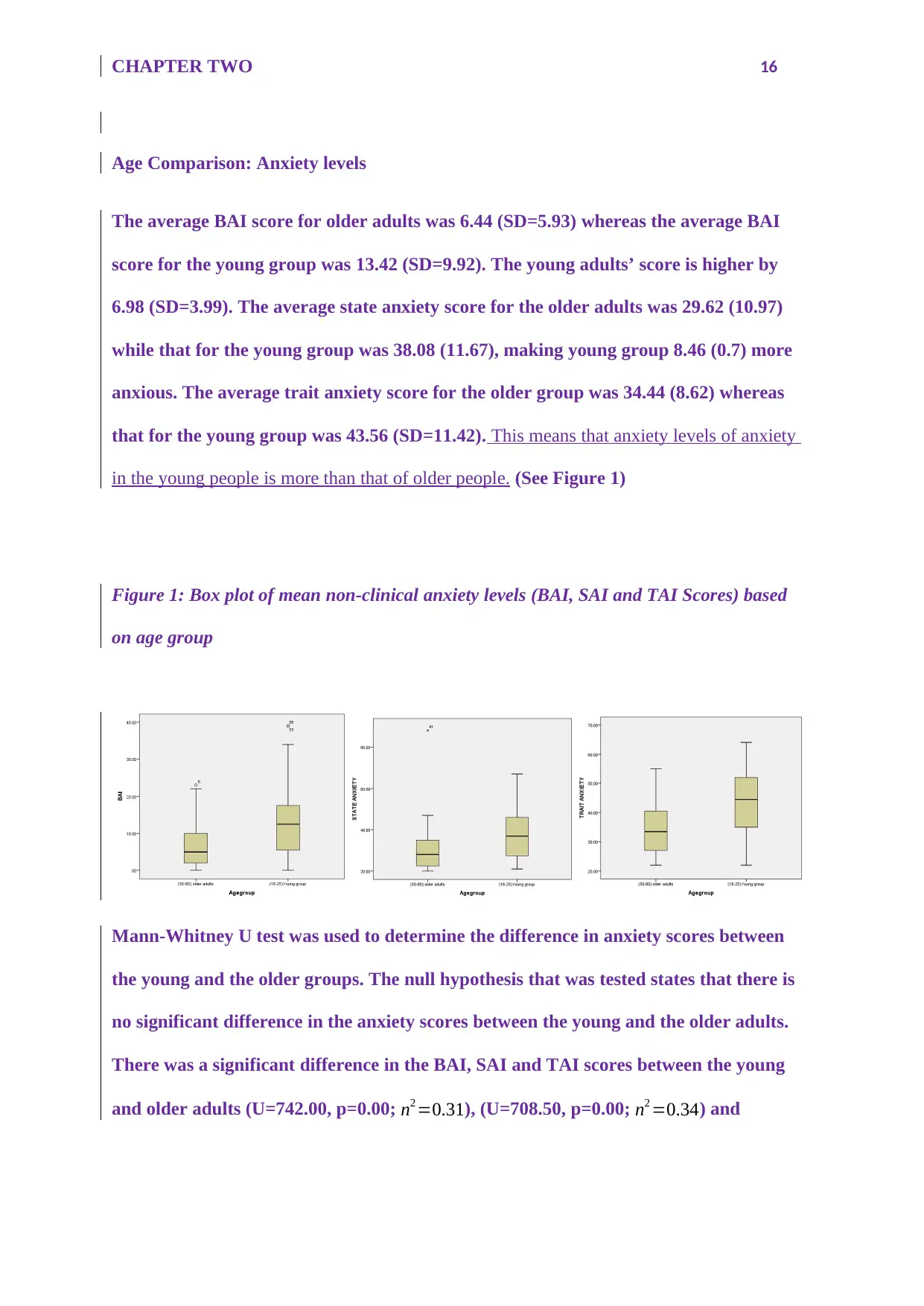
CHAPTER TWO 16
Age Comparison: Anxiety levels
The average BAI score for older adults was 6.44 (SD=5.93) whereas the average BAI
score for the young group was 13.42 (SD=9.92). The young adults’ score is higher by
6.98 (SD=3.99). The average state anxiety score for the older adults was 29.62 (10.97)
while that for the young group was 38.08 (11.67), making young group 8.46 (0.7) more
anxious. The average trait anxiety score for the older group was 34.44 (8.62) whereas
that for the young group was 43.56 (SD=11.42). This means that anxiety levels of anxiety
in the young people is more than that of older people. (See Figure 1)
Figure 1: Box plot of mean non-clinical anxiety levels (BAI, SAI and TAI Scores) based
on age group
Mann-Whitney U test was used to determine the difference in anxiety scores between
the young and the older groups. The null hypothesis that was tested states that there is
no significant difference in the anxiety scores between the young and the older adults.
There was a significant difference in the BAI, SAI and TAI scores between the young
and older adults (U=742.00, p=0.00; n2 =0.31), (U=708.50, p=0.00; n2 =0.34) and
Age Comparison: Anxiety levels
The average BAI score for older adults was 6.44 (SD=5.93) whereas the average BAI
score for the young group was 13.42 (SD=9.92). The young adults’ score is higher by
6.98 (SD=3.99). The average state anxiety score for the older adults was 29.62 (10.97)
while that for the young group was 38.08 (11.67), making young group 8.46 (0.7) more
anxious. The average trait anxiety score for the older group was 34.44 (8.62) whereas
that for the young group was 43.56 (SD=11.42). This means that anxiety levels of anxiety
in the young people is more than that of older people. (See Figure 1)
Figure 1: Box plot of mean non-clinical anxiety levels (BAI, SAI and TAI Scores) based
on age group
Mann-Whitney U test was used to determine the difference in anxiety scores between
the young and the older groups. The null hypothesis that was tested states that there is
no significant difference in the anxiety scores between the young and the older adults.
There was a significant difference in the BAI, SAI and TAI scores between the young
and older adults (U=742.00, p=0.00; n2 =0.31), (U=708.50, p=0.00; n2 =0.34) and
Secure Best Marks with AI Grader
Need help grading? Try our AI Grader for instant feedback on your assignments.
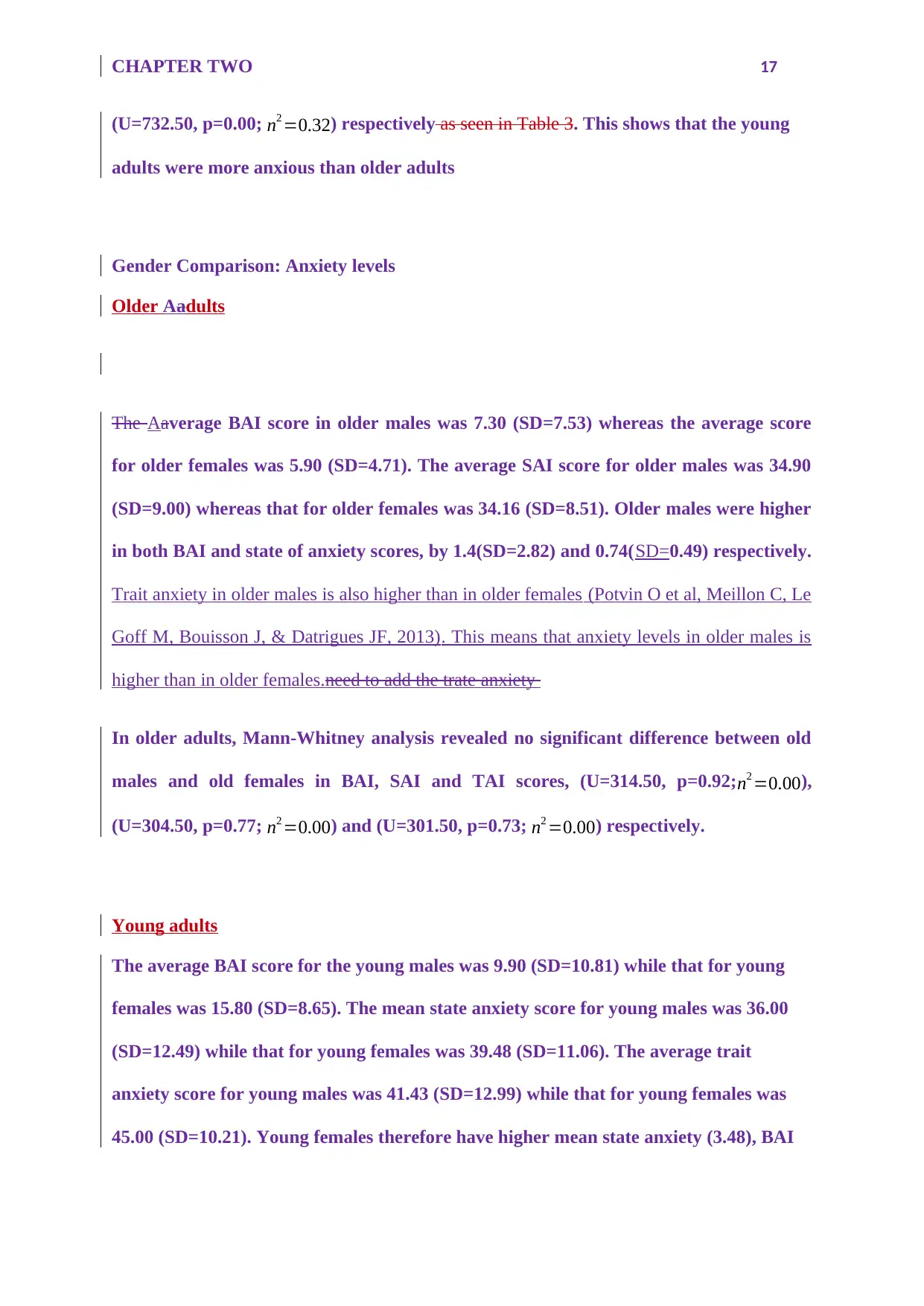
CHAPTER TWO 17
(U=732.50, p=0.00; n2 =0.32) respectively as seen in Table 3. This shows that the young
adults were more anxious than older adults
Gender Comparison: Anxiety levels
Older Aadults
The Aaverage BAI score in older males was 7.30 (SD=7.53) whereas the average score
for older females was 5.90 (SD=4.71). The average SAI score for older males was 34.90
(SD=9.00) whereas that for older females was 34.16 (SD=8.51). Older males were higher
in both BAI and state of anxiety scores, by 1.4(SD=2.82) and 0.74(SD=0.49) respectively.
Trait anxiety in older males is also higher than in older females (Potvin O et al, Meillon C, Le
Goff M, Bouisson J, & Datrigues JF, 2013). This means that anxiety levels in older males is
higher than in older females.need to add the trate anxiety
In older adults, Mann-Whitney analysis revealed no significant difference between old
males and old females in BAI, SAI and TAI scores, (U=314.50, p=0.92; n2 =0.00),
(U=304.50, p=0.77; n2 =0.00) and (U=301.50, p=0.73; n2 =0.00) respectively.
Young adults
The average BAI score for the young males was 9.90 (SD=10.81) while that for young
females was 15.80 (SD=8.65). The mean state anxiety score for young males was 36.00
(SD=12.49) while that for young females was 39.48 (SD=11.06). The average trait
anxiety score for young males was 41.43 (SD=12.99) while that for young females was
45.00 (SD=10.21). Young females therefore have higher mean state anxiety (3.48), BAI
(U=732.50, p=0.00; n2 =0.32) respectively as seen in Table 3. This shows that the young
adults were more anxious than older adults
Gender Comparison: Anxiety levels
Older Aadults
The Aaverage BAI score in older males was 7.30 (SD=7.53) whereas the average score
for older females was 5.90 (SD=4.71). The average SAI score for older males was 34.90
(SD=9.00) whereas that for older females was 34.16 (SD=8.51). Older males were higher
in both BAI and state of anxiety scores, by 1.4(SD=2.82) and 0.74(SD=0.49) respectively.
Trait anxiety in older males is also higher than in older females (Potvin O et al, Meillon C, Le
Goff M, Bouisson J, & Datrigues JF, 2013). This means that anxiety levels in older males is
higher than in older females.need to add the trate anxiety
In older adults, Mann-Whitney analysis revealed no significant difference between old
males and old females in BAI, SAI and TAI scores, (U=314.50, p=0.92; n2 =0.00),
(U=304.50, p=0.77; n2 =0.00) and (U=301.50, p=0.73; n2 =0.00) respectively.
Young adults
The average BAI score for the young males was 9.90 (SD=10.81) while that for young
females was 15.80 (SD=8.65). The mean state anxiety score for young males was 36.00
(SD=12.49) while that for young females was 39.48 (SD=11.06). The average trait
anxiety score for young males was 41.43 (SD=12.99) while that for young females was
45.00 (SD=10.21). Young females therefore have higher mean state anxiety (3.48), BAI
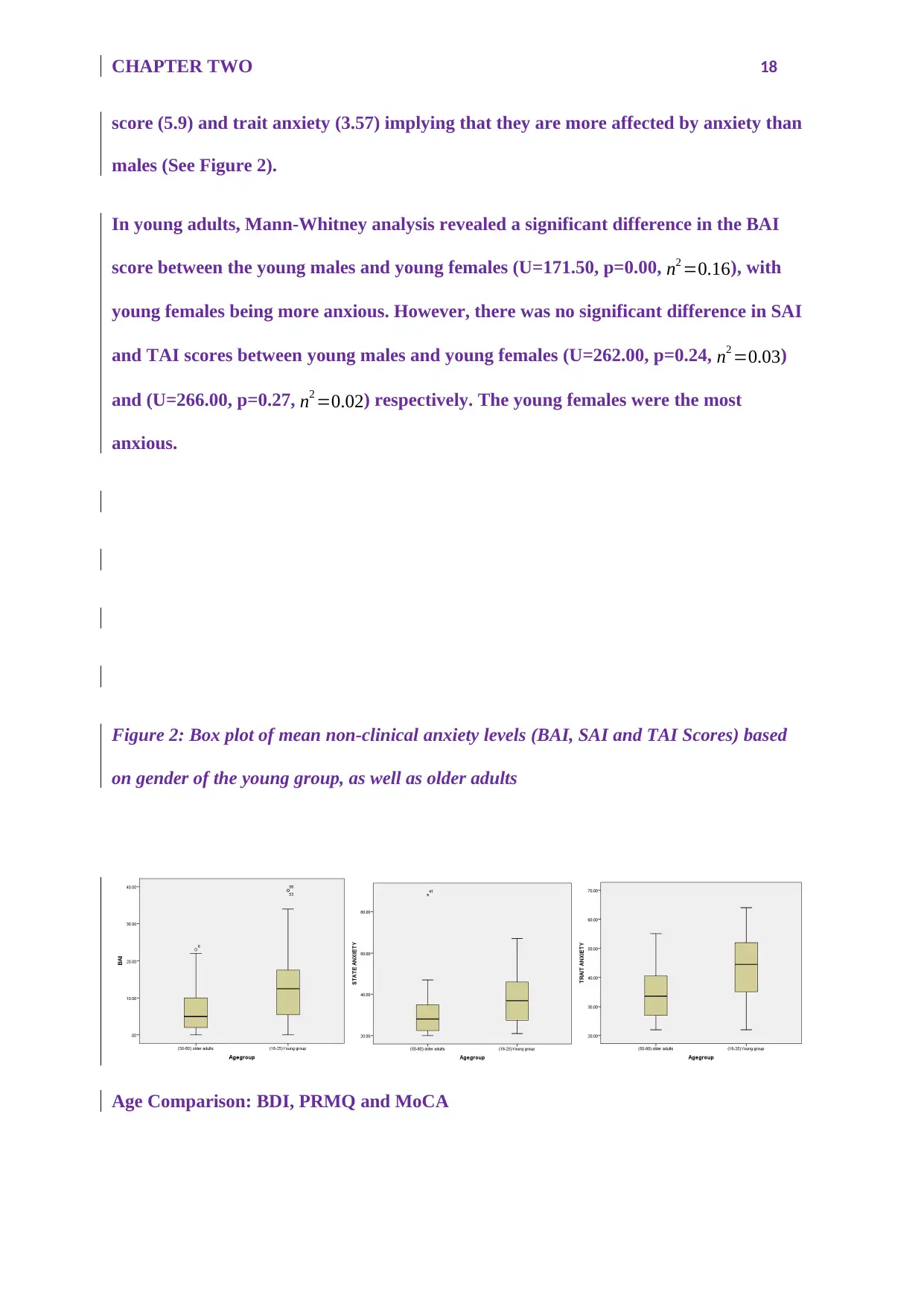
CHAPTER TWO 18
score (5.9) and trait anxiety (3.57) implying that they are more affected by anxiety than
males (See Figure 2).
In young adults, Mann-Whitney analysis revealed a significant difference in the BAI
score between the young males and young females (U=171.50, p=0.00, n2 =0.16), with
young females being more anxious. However, there was no significant difference in SAI
and TAI scores between young males and young females (U=262.00, p=0.24, n2 =0.03)
and (U=266.00, p=0.27, n2 =0.02) respectively. The young females were the most
anxious.
Figure 2: Box plot of mean non-clinical anxiety levels (BAI, SAI and TAI Scores) based
on gender of the young group, as well as older adults
Age Comparison: BDI, PRMQ and MoCA
score (5.9) and trait anxiety (3.57) implying that they are more affected by anxiety than
males (See Figure 2).
In young adults, Mann-Whitney analysis revealed a significant difference in the BAI
score between the young males and young females (U=171.50, p=0.00, n2 =0.16), with
young females being more anxious. However, there was no significant difference in SAI
and TAI scores between young males and young females (U=262.00, p=0.24, n2 =0.03)
and (U=266.00, p=0.27, n2 =0.02) respectively. The young females were the most
anxious.
Figure 2: Box plot of mean non-clinical anxiety levels (BAI, SAI and TAI Scores) based
on gender of the young group, as well as older adults
Age Comparison: BDI, PRMQ and MoCA
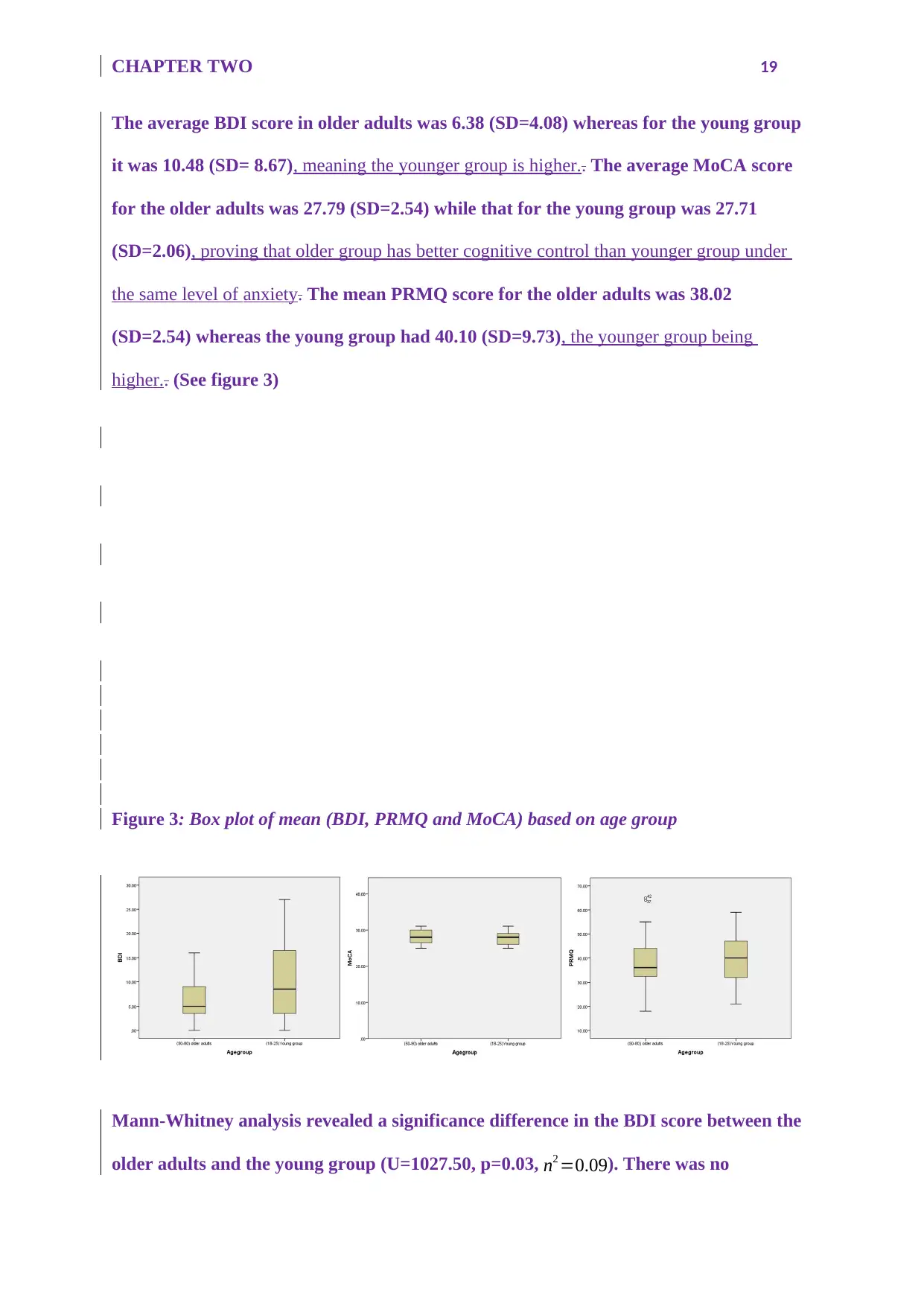
CHAPTER TWO 19
The average BDI score in older adults was 6.38 (SD=4.08) whereas for the young group
it was 10.48 (SD= 8.67), meaning the younger group is higher.. The average MoCA score
for the older adults was 27.79 (SD=2.54) while that for the young group was 27.71
(SD=2.06), proving that older group has better cognitive control than younger group under
the same level of anxiety. The mean PRMQ score for the older adults was 38.02
(SD=2.54) whereas the young group had 40.10 (SD=9.73), the younger group being
higher.. (See figure 3)
Figure 3: Box plot of mean (BDI, PRMQ and MoCA) based on age group
Mann-Whitney analysis revealed a significance difference in the BDI score between the
older adults and the young group (U=1027.50, p=0.03, n2 =0.09). There was no
The average BDI score in older adults was 6.38 (SD=4.08) whereas for the young group
it was 10.48 (SD= 8.67), meaning the younger group is higher.. The average MoCA score
for the older adults was 27.79 (SD=2.54) while that for the young group was 27.71
(SD=2.06), proving that older group has better cognitive control than younger group under
the same level of anxiety. The mean PRMQ score for the older adults was 38.02
(SD=2.54) whereas the young group had 40.10 (SD=9.73), the younger group being
higher.. (See figure 3)
Figure 3: Box plot of mean (BDI, PRMQ and MoCA) based on age group
Mann-Whitney analysis revealed a significance difference in the BDI score between the
older adults and the young group (U=1027.50, p=0.03, n2 =0.09). There was no
Paraphrase This Document
Need a fresh take? Get an instant paraphrase of this document with our AI Paraphraser
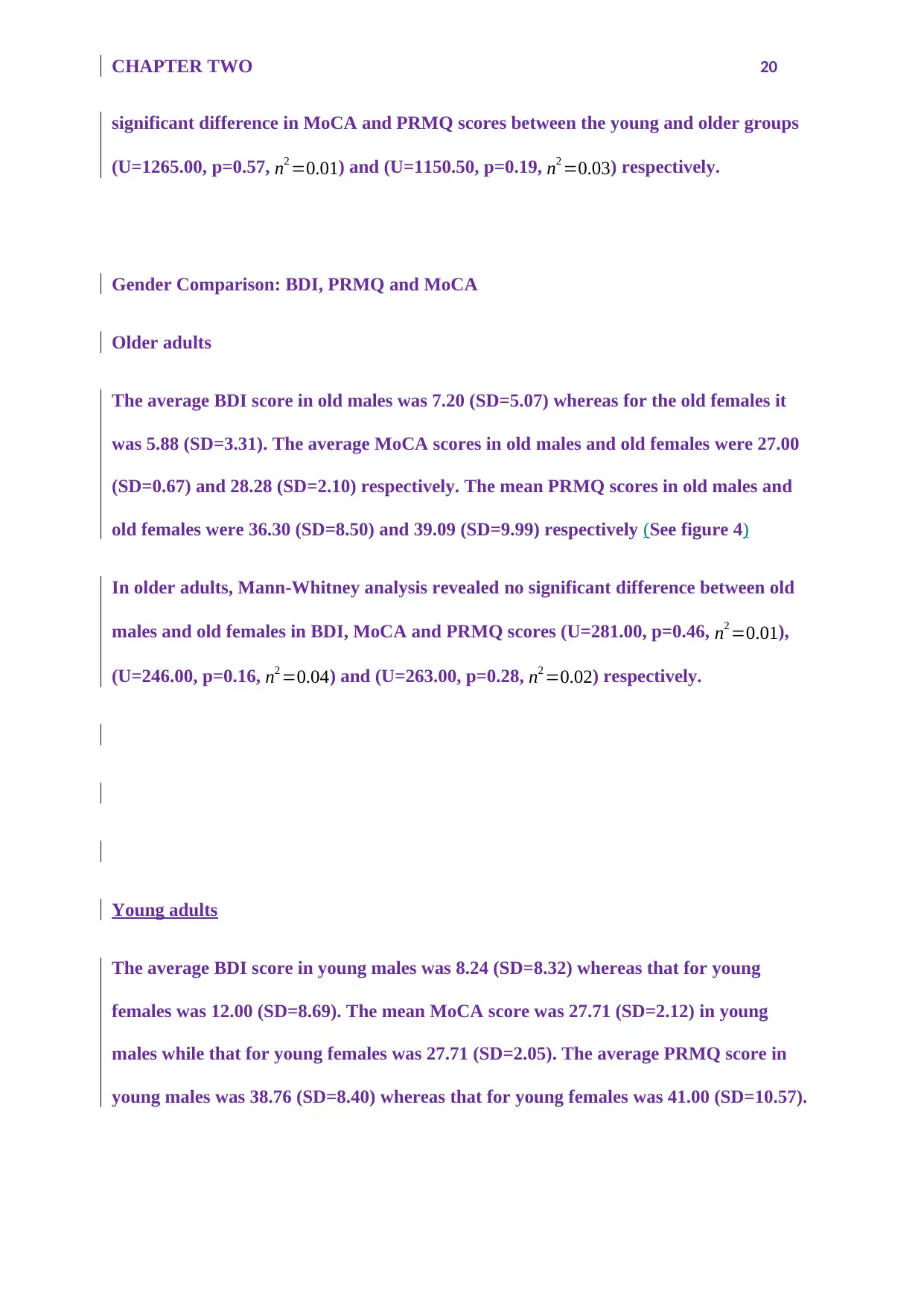
CHAPTER TWO 20
significant difference in MoCA and PRMQ scores between the young and older groups
(U=1265.00, p=0.57, n2 =0.01) and (U=1150.50, p=0.19, n2 =0.03) respectively.
Gender Comparison: BDI, PRMQ and MoCA
Older adults
The average BDI score in old males was 7.20 (SD=5.07) whereas for the old females it
was 5.88 (SD=3.31). The average MoCA scores in old males and old females were 27.00
(SD=0.67) and 28.28 (SD=2.10) respectively. The mean PRMQ scores in old males and
old females were 36.30 (SD=8.50) and 39.09 (SD=9.99) respectively (See figure 4)
In older adults, Mann-Whitney analysis revealed no significant difference between old
males and old females in BDI, MoCA and PRMQ scores (U=281.00, p=0.46, n2 =0.01),
(U=246.00, p=0.16, n2 =0.04) and (U=263.00, p=0.28, n2 =0.02) respectively.
Young adults
The average BDI score in young males was 8.24 (SD=8.32) whereas that for young
females was 12.00 (SD=8.69). The mean MoCA score was 27.71 (SD=2.12) in young
males while that for young females was 27.71 (SD=2.05). The average PRMQ score in
young males was 38.76 (SD=8.40) whereas that for young females was 41.00 (SD=10.57).
significant difference in MoCA and PRMQ scores between the young and older groups
(U=1265.00, p=0.57, n2 =0.01) and (U=1150.50, p=0.19, n2 =0.03) respectively.
Gender Comparison: BDI, PRMQ and MoCA
Older adults
The average BDI score in old males was 7.20 (SD=5.07) whereas for the old females it
was 5.88 (SD=3.31). The average MoCA scores in old males and old females were 27.00
(SD=0.67) and 28.28 (SD=2.10) respectively. The mean PRMQ scores in old males and
old females were 36.30 (SD=8.50) and 39.09 (SD=9.99) respectively (See figure 4)
In older adults, Mann-Whitney analysis revealed no significant difference between old
males and old females in BDI, MoCA and PRMQ scores (U=281.00, p=0.46, n2 =0.01),
(U=246.00, p=0.16, n2 =0.04) and (U=263.00, p=0.28, n2 =0.02) respectively.
Young adults
The average BDI score in young males was 8.24 (SD=8.32) whereas that for young
females was 12.00 (SD=8.69). The mean MoCA score was 27.71 (SD=2.12) in young
males while that for young females was 27.71 (SD=2.05). The average PRMQ score in
young males was 38.76 (SD=8.40) whereas that for young females was 41.00 (SD=10.57).

CHAPTER TWO 21
In young adults, Mann-Whitney analysis revealed no significant difference in BDI,
MoCA and PRMQ scores between young males and young females (U=235.00, p=0.09,
n2 =0.06), (U=323.00, p=0.96, n2 =0.00) and (U=287.50, p=0.48, n2 =0.01) respectively.
Figure 4: Box plot of mean for (BDI, PRMQ, MoCA scores) in old males and females
Correlation Analysis
This study employed Spearman’s correlation to determine the strength and direction of
relationship between variables.
Correlation based on age
Correlation between anxiety levels and age
There is a negative significant correlation between the trait anxiety and age in the old
group (r=-.31, p=0.26); this shows that the age and the trait anxiety are inversely related
among the old adults. There is no significant correlation between age and other aspects
of anxiety levels among older adults; in addition, there is no any significant correlation
between the aspects of anxiety levels and the young group. Anxiety in general decreases
with age. With older age, one becomes internally focused and they increasingly focused
on integrity, wisdom and making peace with one another.
Correlation between BAI, SAI and TAI levels
In young adults, Mann-Whitney analysis revealed no significant difference in BDI,
MoCA and PRMQ scores between young males and young females (U=235.00, p=0.09,
n2 =0.06), (U=323.00, p=0.96, n2 =0.00) and (U=287.50, p=0.48, n2 =0.01) respectively.
Figure 4: Box plot of mean for (BDI, PRMQ, MoCA scores) in old males and females
Correlation Analysis
This study employed Spearman’s correlation to determine the strength and direction of
relationship between variables.
Correlation based on age
Correlation between anxiety levels and age
There is a negative significant correlation between the trait anxiety and age in the old
group (r=-.31, p=0.26); this shows that the age and the trait anxiety are inversely related
among the old adults. There is no significant correlation between age and other aspects
of anxiety levels among older adults; in addition, there is no any significant correlation
between the aspects of anxiety levels and the young group. Anxiety in general decreases
with age. With older age, one becomes internally focused and they increasingly focused
on integrity, wisdom and making peace with one another.
Correlation between BAI, SAI and TAI levels
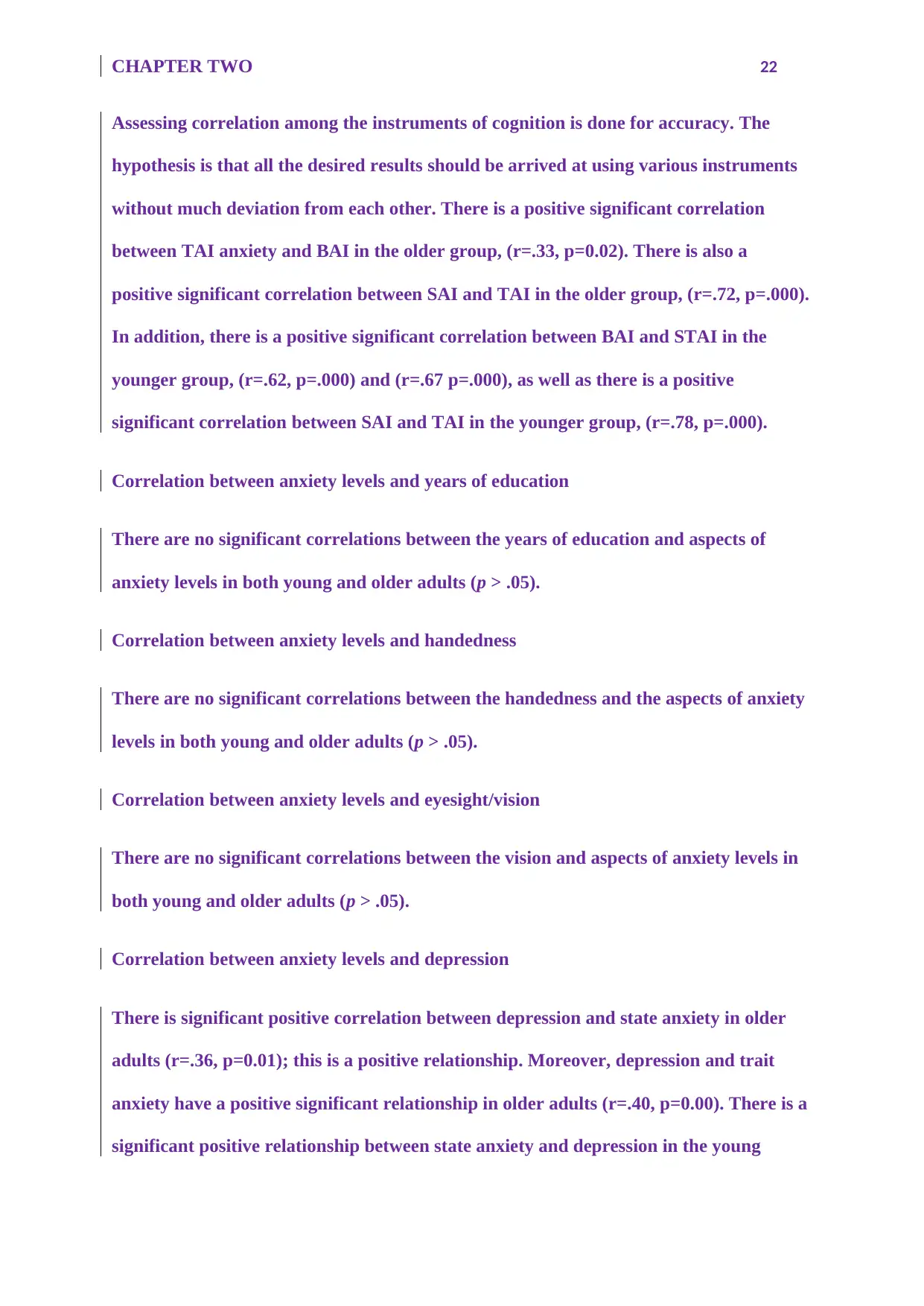
CHAPTER TWO 22
Assessing correlation among the instruments of cognition is done for accuracy. The
hypothesis is that all the desired results should be arrived at using various instruments
without much deviation from each other. There is a positive significant correlation
between TAI anxiety and BAI in the older group, (r=.33, p=0.02). There is also a
positive significant correlation between SAI and TAI in the older group, (r=.72, p=.000).
In addition, there is a positive significant correlation between BAI and STAI in the
younger group, (r=.62, p=.000) and (r=.67 p=.000), as well as there is a positive
significant correlation between SAI and TAI in the younger group, (r=.78, p=.000).
Correlation between anxiety levels and years of education
There are no significant correlations between the years of education and aspects of
anxiety levels in both young and older adults (p > .05).
Correlation between anxiety levels and handedness
There are no significant correlations between the handedness and the aspects of anxiety
levels in both young and older adults (p > .05).
Correlation between anxiety levels and eyesight/vision
There are no significant correlations between the vision and aspects of anxiety levels in
both young and older adults (p > .05).
Correlation between anxiety levels and depression
There is significant positive correlation between depression and state anxiety in older
adults (r=.36, p=0.01); this is a positive relationship. Moreover, depression and trait
anxiety have a positive significant relationship in older adults (r=.40, p=0.00). There is a
significant positive relationship between state anxiety and depression in the young
Assessing correlation among the instruments of cognition is done for accuracy. The
hypothesis is that all the desired results should be arrived at using various instruments
without much deviation from each other. There is a positive significant correlation
between TAI anxiety and BAI in the older group, (r=.33, p=0.02). There is also a
positive significant correlation between SAI and TAI in the older group, (r=.72, p=.000).
In addition, there is a positive significant correlation between BAI and STAI in the
younger group, (r=.62, p=.000) and (r=.67 p=.000), as well as there is a positive
significant correlation between SAI and TAI in the younger group, (r=.78, p=.000).
Correlation between anxiety levels and years of education
There are no significant correlations between the years of education and aspects of
anxiety levels in both young and older adults (p > .05).
Correlation between anxiety levels and handedness
There are no significant correlations between the handedness and the aspects of anxiety
levels in both young and older adults (p > .05).
Correlation between anxiety levels and eyesight/vision
There are no significant correlations between the vision and aspects of anxiety levels in
both young and older adults (p > .05).
Correlation between anxiety levels and depression
There is significant positive correlation between depression and state anxiety in older
adults (r=.36, p=0.01); this is a positive relationship. Moreover, depression and trait
anxiety have a positive significant relationship in older adults (r=.40, p=0.00). There is a
significant positive relationship between state anxiety and depression in the young
Secure Best Marks with AI Grader
Need help grading? Try our AI Grader for instant feedback on your assignments.
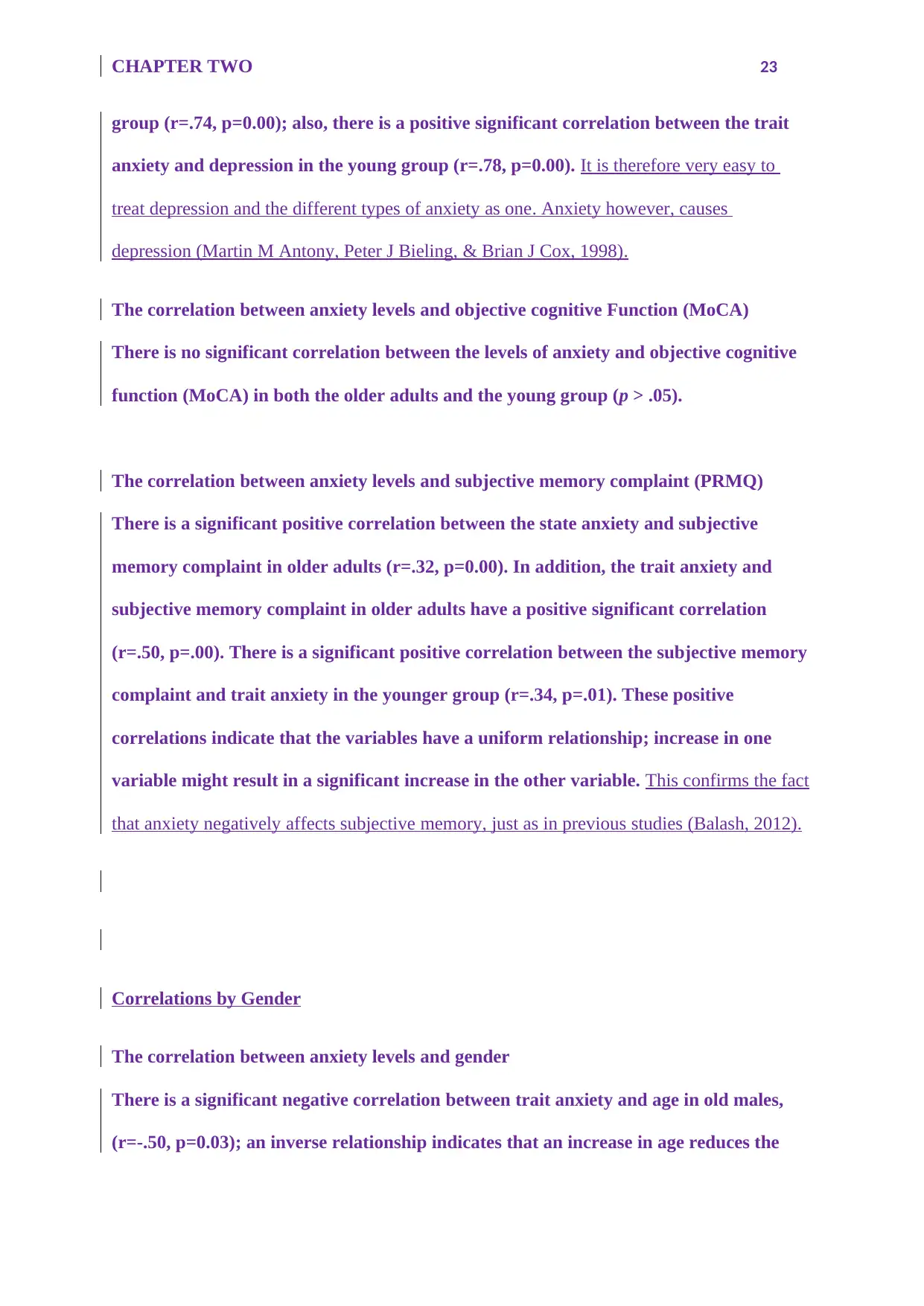
CHAPTER TWO 23
group (r=.74, p=0.00); also, there is a positive significant correlation between the trait
anxiety and depression in the young group (r=.78, p=0.00). It is therefore very easy to
treat depression and the different types of anxiety as one. Anxiety however, causes
depression (Martin M Antony, Peter J Bieling, & Brian J Cox, 1998).
The correlation between anxiety levels and objective cognitive Function (MoCA)
There is no significant correlation between the levels of anxiety and objective cognitive
function (MoCA) in both the older adults and the young group (p > .05).
The correlation between anxiety levels and subjective memory complaint (PRMQ)
There is a significant positive correlation between the state anxiety and subjective
memory complaint in older adults (r=.32, p=0.00). In addition, the trait anxiety and
subjective memory complaint in older adults have a positive significant correlation
(r=.50, p=.00). There is a significant positive correlation between the subjective memory
complaint and trait anxiety in the younger group (r=.34, p=.01). These positive
correlations indicate that the variables have a uniform relationship; increase in one
variable might result in a significant increase in the other variable. This confirms the fact
that anxiety negatively affects subjective memory, just as in previous studies (Balash, 2012).
Correlations by Gender
The correlation between anxiety levels and gender
There is a significant negative correlation between trait anxiety and age in old males,
(r=-.50, p=0.03); an inverse relationship indicates that an increase in age reduces the
group (r=.74, p=0.00); also, there is a positive significant correlation between the trait
anxiety and depression in the young group (r=.78, p=0.00). It is therefore very easy to
treat depression and the different types of anxiety as one. Anxiety however, causes
depression (Martin M Antony, Peter J Bieling, & Brian J Cox, 1998).
The correlation between anxiety levels and objective cognitive Function (MoCA)
There is no significant correlation between the levels of anxiety and objective cognitive
function (MoCA) in both the older adults and the young group (p > .05).
The correlation between anxiety levels and subjective memory complaint (PRMQ)
There is a significant positive correlation between the state anxiety and subjective
memory complaint in older adults (r=.32, p=0.00). In addition, the trait anxiety and
subjective memory complaint in older adults have a positive significant correlation
(r=.50, p=.00). There is a significant positive correlation between the subjective memory
complaint and trait anxiety in the younger group (r=.34, p=.01). These positive
correlations indicate that the variables have a uniform relationship; increase in one
variable might result in a significant increase in the other variable. This confirms the fact
that anxiety negatively affects subjective memory, just as in previous studies (Balash, 2012).
Correlations by Gender
The correlation between anxiety levels and gender
There is a significant negative correlation between trait anxiety and age in old males,
(r=-.50, p=0.03); an inverse relationship indicates that an increase in age reduces the
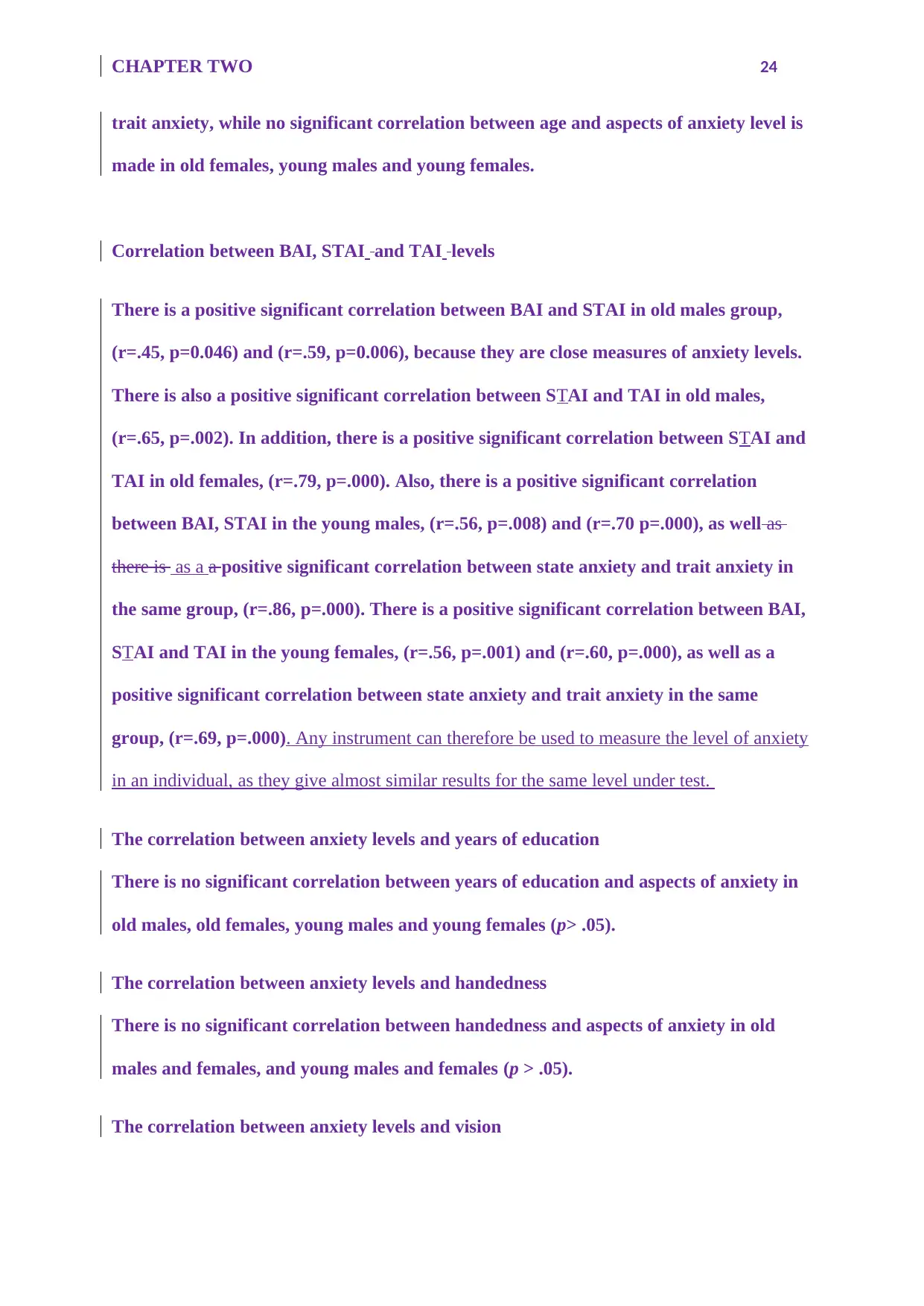
CHAPTER TWO 24
trait anxiety, while no significant correlation between age and aspects of anxiety level is
made in old females, young males and young females.
Correlation between BAI, STAI and TAI levels
There is a positive significant correlation between BAI and STAI in old males group,
(r=.45, p=0.046) and (r=.59, p=0.006), because they are close measures of anxiety levels.
There is also a positive significant correlation between STAI and TAI in old males,
(r=.65, p=.002). In addition, there is a positive significant correlation between STAI and
TAI in old females, (r=.79, p=.000). Also, there is a positive significant correlation
between BAI, STAI in the young males, (r=.56, p=.008) and (r=.70 p=.000), as well as
there is as a a positive significant correlation between state anxiety and trait anxiety in
the same group, (r=.86, p=.000). There is a positive significant correlation between BAI,
STAI and TAI in the young females, (r=.56, p=.001) and (r=.60, p=.000), as well as a
positive significant correlation between state anxiety and trait anxiety in the same
group, (r=.69, p=.000). Any instrument can therefore be used to measure the level of anxiety
in an individual, as they give almost similar results for the same level under test.
The correlation between anxiety levels and years of education
There is no significant correlation between years of education and aspects of anxiety in
old males, old females, young males and young females (p> .05).
The correlation between anxiety levels and handedness
There is no significant correlation between handedness and aspects of anxiety in old
males and females, and young males and females (p > .05).
The correlation between anxiety levels and vision
trait anxiety, while no significant correlation between age and aspects of anxiety level is
made in old females, young males and young females.
Correlation between BAI, STAI and TAI levels
There is a positive significant correlation between BAI and STAI in old males group,
(r=.45, p=0.046) and (r=.59, p=0.006), because they are close measures of anxiety levels.
There is also a positive significant correlation between STAI and TAI in old males,
(r=.65, p=.002). In addition, there is a positive significant correlation between STAI and
TAI in old females, (r=.79, p=.000). Also, there is a positive significant correlation
between BAI, STAI in the young males, (r=.56, p=.008) and (r=.70 p=.000), as well as
there is as a a positive significant correlation between state anxiety and trait anxiety in
the same group, (r=.86, p=.000). There is a positive significant correlation between BAI,
STAI and TAI in the young females, (r=.56, p=.001) and (r=.60, p=.000), as well as a
positive significant correlation between state anxiety and trait anxiety in the same
group, (r=.69, p=.000). Any instrument can therefore be used to measure the level of anxiety
in an individual, as they give almost similar results for the same level under test.
The correlation between anxiety levels and years of education
There is no significant correlation between years of education and aspects of anxiety in
old males, old females, young males and young females (p> .05).
The correlation between anxiety levels and handedness
There is no significant correlation between handedness and aspects of anxiety in old
males and females, and young males and females (p > .05).
The correlation between anxiety levels and vision
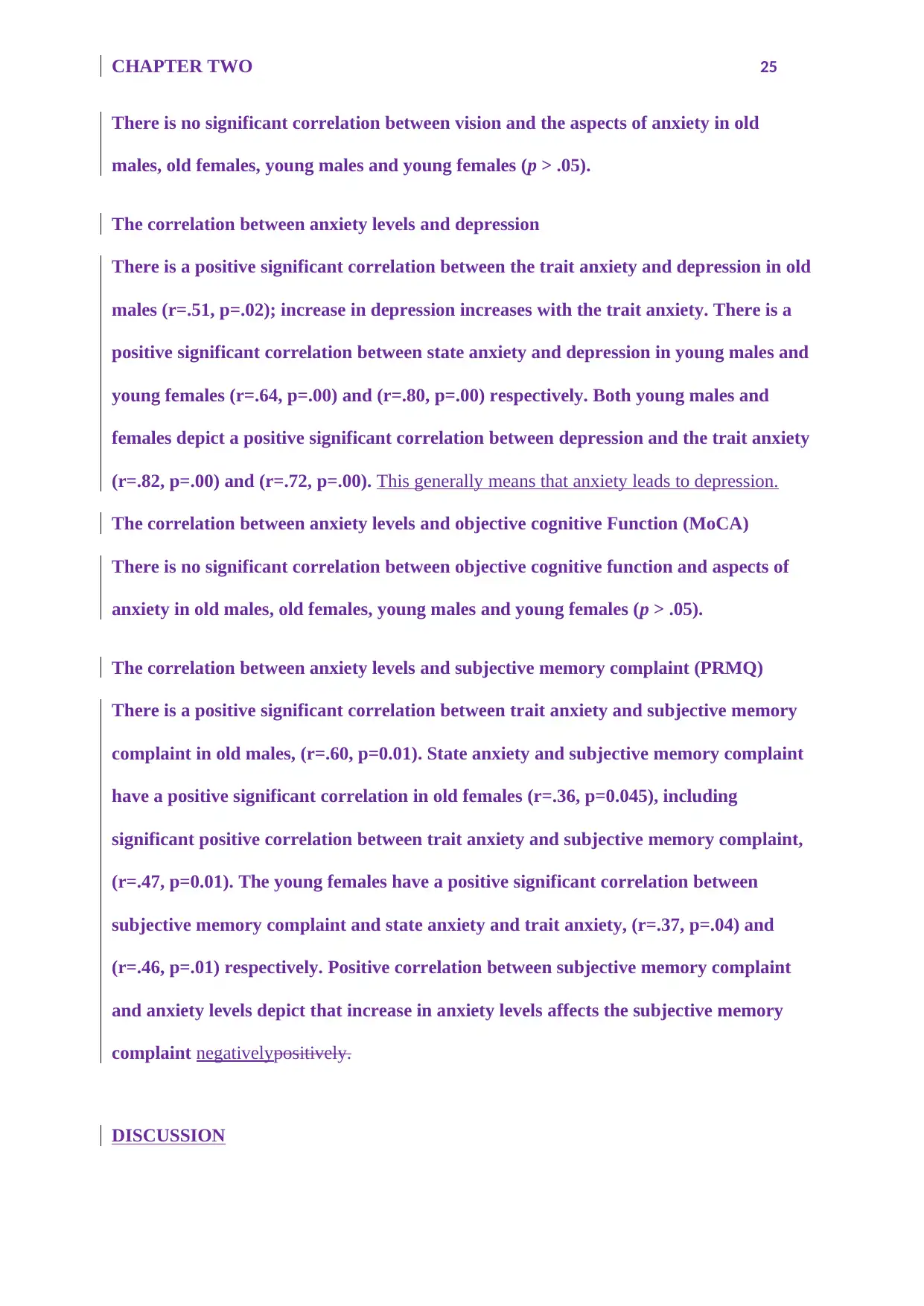
CHAPTER TWO 25
There is no significant correlation between vision and the aspects of anxiety in old
males, old females, young males and young females (p > .05).
The correlation between anxiety levels and depression
There is a positive significant correlation between the trait anxiety and depression in old
males (r=.51, p=.02); increase in depression increases with the trait anxiety. There is a
positive significant correlation between state anxiety and depression in young males and
young females (r=.64, p=.00) and (r=.80, p=.00) respectively. Both young males and
females depict a positive significant correlation between depression and the trait anxiety
(r=.82, p=.00) and (r=.72, p=.00). This generally means that anxiety leads to depression.
The correlation between anxiety levels and objective cognitive Function (MoCA)
There is no significant correlation between objective cognitive function and aspects of
anxiety in old males, old females, young males and young females (p > .05).
The correlation between anxiety levels and subjective memory complaint (PRMQ)
There is a positive significant correlation between trait anxiety and subjective memory
complaint in old males, (r=.60, p=0.01). State anxiety and subjective memory complaint
have a positive significant correlation in old females (r=.36, p=0.045), including
significant positive correlation between trait anxiety and subjective memory complaint,
(r=.47, p=0.01). The young females have a positive significant correlation between
subjective memory complaint and state anxiety and trait anxiety, (r=.37, p=.04) and
(r=.46, p=.01) respectively. Positive correlation between subjective memory complaint
and anxiety levels depict that increase in anxiety levels affects the subjective memory
complaint negativelypositively.
DISCUSSION
There is no significant correlation between vision and the aspects of anxiety in old
males, old females, young males and young females (p > .05).
The correlation between anxiety levels and depression
There is a positive significant correlation between the trait anxiety and depression in old
males (r=.51, p=.02); increase in depression increases with the trait anxiety. There is a
positive significant correlation between state anxiety and depression in young males and
young females (r=.64, p=.00) and (r=.80, p=.00) respectively. Both young males and
females depict a positive significant correlation between depression and the trait anxiety
(r=.82, p=.00) and (r=.72, p=.00). This generally means that anxiety leads to depression.
The correlation between anxiety levels and objective cognitive Function (MoCA)
There is no significant correlation between objective cognitive function and aspects of
anxiety in old males, old females, young males and young females (p > .05).
The correlation between anxiety levels and subjective memory complaint (PRMQ)
There is a positive significant correlation between trait anxiety and subjective memory
complaint in old males, (r=.60, p=0.01). State anxiety and subjective memory complaint
have a positive significant correlation in old females (r=.36, p=0.045), including
significant positive correlation between trait anxiety and subjective memory complaint,
(r=.47, p=0.01). The young females have a positive significant correlation between
subjective memory complaint and state anxiety and trait anxiety, (r=.37, p=.04) and
(r=.46, p=.01) respectively. Positive correlation between subjective memory complaint
and anxiety levels depict that increase in anxiety levels affects the subjective memory
complaint negativelypositively.
DISCUSSION
Paraphrase This Document
Need a fresh take? Get an instant paraphrase of this document with our AI Paraphraser
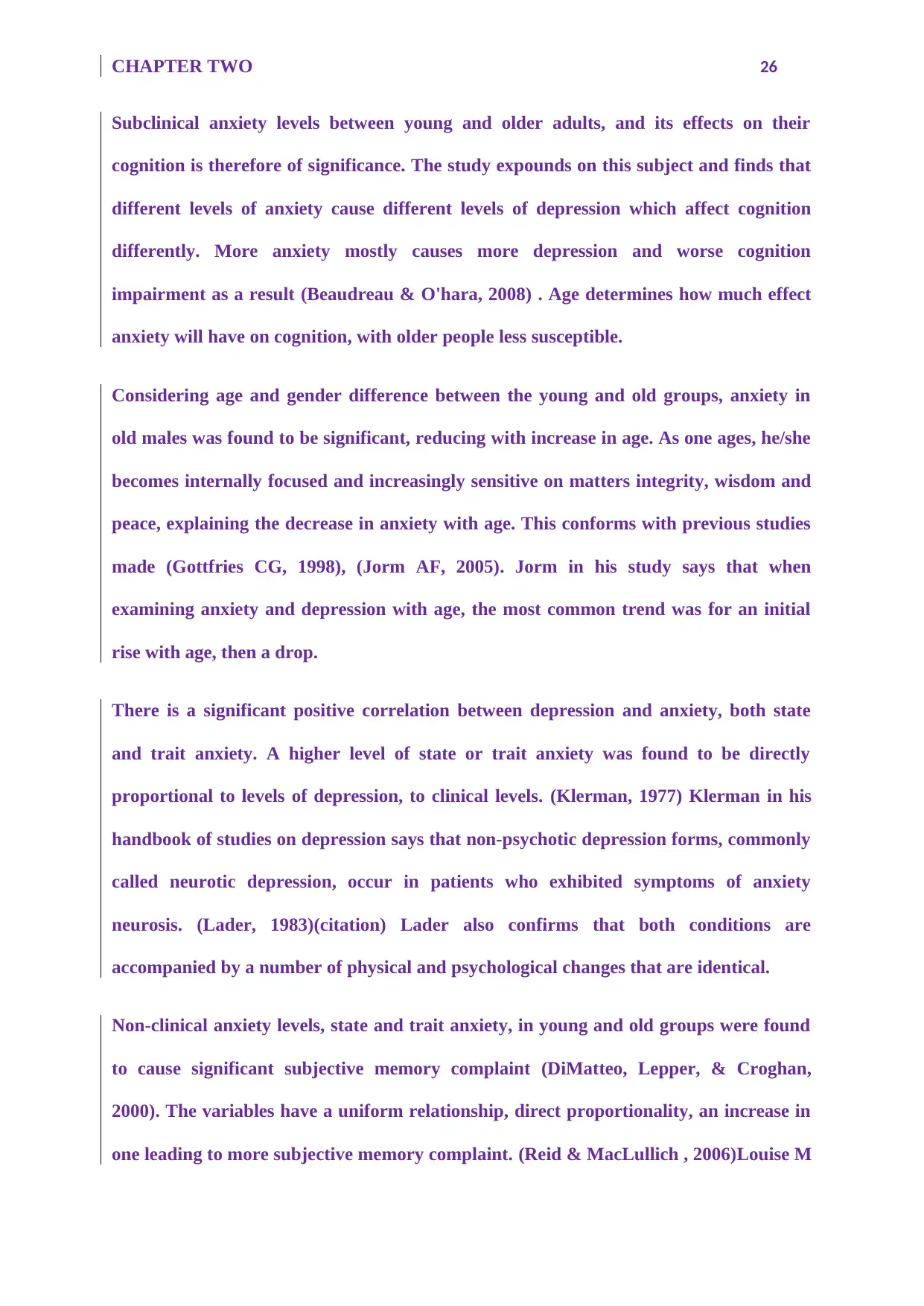
CHAPTER TWO 26
Subclinical anxiety levels between young and older adults, and its effects on their
cognition is therefore of significance. The study expounds on this subject and finds that
different levels of anxiety cause different levels of depression which affect cognition
differently. More anxiety mostly causes more depression and worse cognition
impairment as a result (Beaudreau & O'hara, 2008) . Age determines how much effect
anxiety will have on cognition, with older people less susceptible.
Considering age and gender difference between the young and old groups, anxiety in
old males was found to be significant, reducing with increase in age. As one ages, he/she
becomes internally focused and increasingly sensitive on matters integrity, wisdom and
peace, explaining the decrease in anxiety with age. This conforms with previous studies
made (Gottfries CG, 1998), (Jorm AF, 2005). Jorm in his study says that when
examining anxiety and depression with age, the most common trend was for an initial
rise with age, then a drop.
There is a significant positive correlation between depression and anxiety, both state
and trait anxiety. A higher level of state or trait anxiety was found to be directly
proportional to levels of depression, to clinical levels. (Klerman, 1977) Klerman in his
handbook of studies on depression says that non-psychotic depression forms, commonly
called neurotic depression, occur in patients who exhibited symptoms of anxiety
neurosis. (Lader, 1983)(citation) Lader also confirms that both conditions are
accompanied by a number of physical and psychological changes that are identical.
Non-clinical anxiety levels, state and trait anxiety, in young and old groups were found
to cause significant subjective memory complaint (DiMatteo, Lepper, & Croghan,
2000). The variables have a uniform relationship, direct proportionality, an increase in
one leading to more subjective memory complaint. (Reid & MacLullich , 2006)Louise M
Subclinical anxiety levels between young and older adults, and its effects on their
cognition is therefore of significance. The study expounds on this subject and finds that
different levels of anxiety cause different levels of depression which affect cognition
differently. More anxiety mostly causes more depression and worse cognition
impairment as a result (Beaudreau & O'hara, 2008) . Age determines how much effect
anxiety will have on cognition, with older people less susceptible.
Considering age and gender difference between the young and old groups, anxiety in
old males was found to be significant, reducing with increase in age. As one ages, he/she
becomes internally focused and increasingly sensitive on matters integrity, wisdom and
peace, explaining the decrease in anxiety with age. This conforms with previous studies
made (Gottfries CG, 1998), (Jorm AF, 2005). Jorm in his study says that when
examining anxiety and depression with age, the most common trend was for an initial
rise with age, then a drop.
There is a significant positive correlation between depression and anxiety, both state
and trait anxiety. A higher level of state or trait anxiety was found to be directly
proportional to levels of depression, to clinical levels. (Klerman, 1977) Klerman in his
handbook of studies on depression says that non-psychotic depression forms, commonly
called neurotic depression, occur in patients who exhibited symptoms of anxiety
neurosis. (Lader, 1983)(citation) Lader also confirms that both conditions are
accompanied by a number of physical and psychological changes that are identical.
Non-clinical anxiety levels, state and trait anxiety, in young and old groups were found
to cause significant subjective memory complaint (DiMatteo, Lepper, & Croghan,
2000). The variables have a uniform relationship, direct proportionality, an increase in
one leading to more subjective memory complaint. (Reid & MacLullich , 2006)Louise M
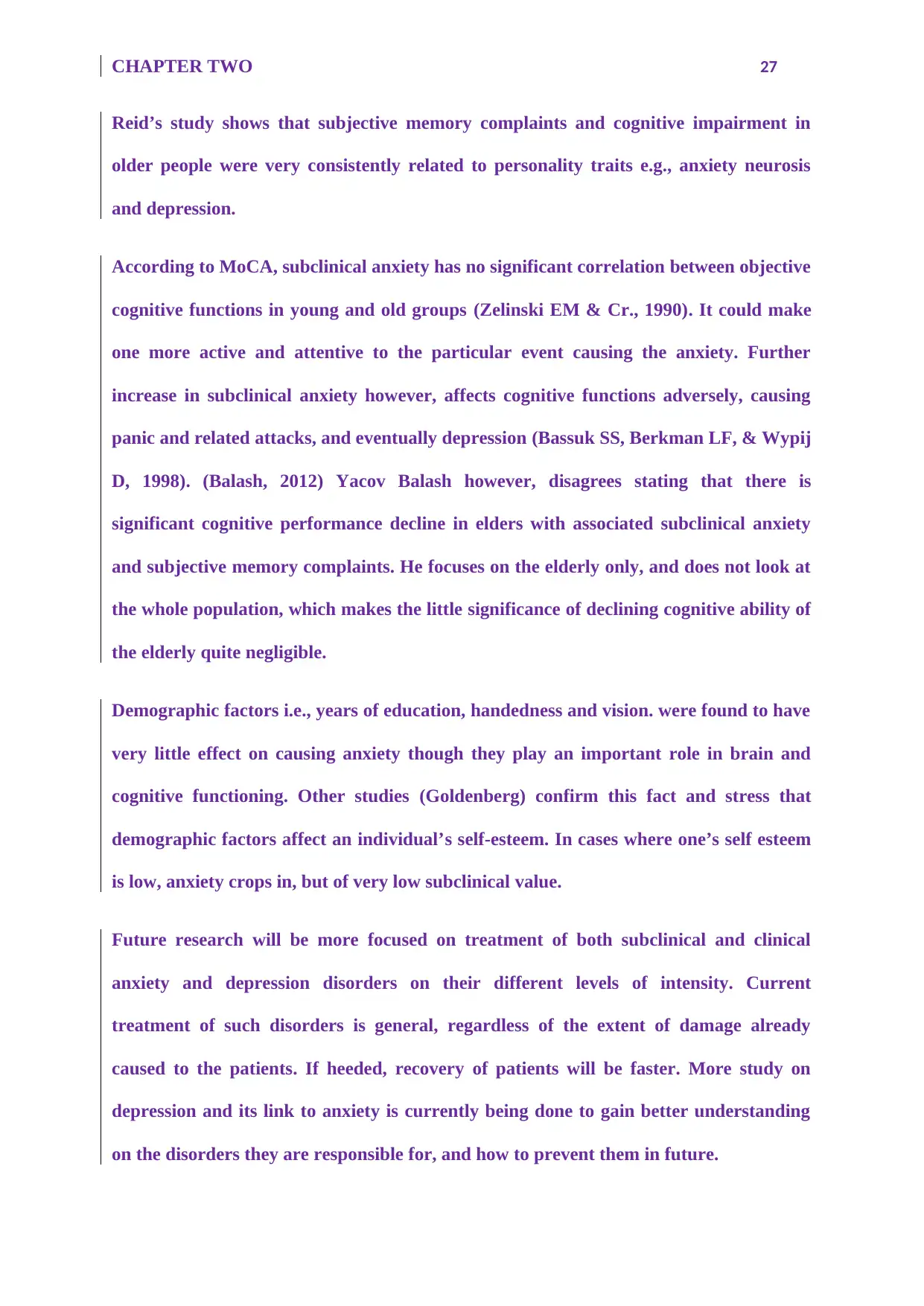
CHAPTER TWO 27
Reid’s study shows that subjective memory complaints and cognitive impairment in
older people were very consistently related to personality traits e.g., anxiety neurosis
and depression.
According to MoCA, subclinical anxiety has no significant correlation between objective
cognitive functions in young and old groups (Zelinski EM & Cr., 1990). It could make
one more active and attentive to the particular event causing the anxiety. Further
increase in subclinical anxiety however, affects cognitive functions adversely, causing
panic and related attacks, and eventually depression (Bassuk SS, Berkman LF, & Wypij
D, 1998). (Balash, 2012) Yacov Balash however, disagrees stating that there is
significant cognitive performance decline in elders with associated subclinical anxiety
and subjective memory complaints. He focuses on the elderly only, and does not look at
the whole population, which makes the little significance of declining cognitive ability of
the elderly quite negligible.
Demographic factors i.e., years of education, handedness and vision. were found to have
very little effect on causing anxiety though they play an important role in brain and
cognitive functioning. Other studies (Goldenberg) confirm this fact and stress that
demographic factors affect an individual’s self-esteem. In cases where one’s self esteem
is low, anxiety crops in, but of very low subclinical value.
Future research will be more focused on treatment of both subclinical and clinical
anxiety and depression disorders on their different levels of intensity. Current
treatment of such disorders is general, regardless of the extent of damage already
caused to the patients. If heeded, recovery of patients will be faster. More study on
depression and its link to anxiety is currently being done to gain better understanding
on the disorders they are responsible for, and how to prevent them in future.
Reid’s study shows that subjective memory complaints and cognitive impairment in
older people were very consistently related to personality traits e.g., anxiety neurosis
and depression.
According to MoCA, subclinical anxiety has no significant correlation between objective
cognitive functions in young and old groups (Zelinski EM & Cr., 1990). It could make
one more active and attentive to the particular event causing the anxiety. Further
increase in subclinical anxiety however, affects cognitive functions adversely, causing
panic and related attacks, and eventually depression (Bassuk SS, Berkman LF, & Wypij
D, 1998). (Balash, 2012) Yacov Balash however, disagrees stating that there is
significant cognitive performance decline in elders with associated subclinical anxiety
and subjective memory complaints. He focuses on the elderly only, and does not look at
the whole population, which makes the little significance of declining cognitive ability of
the elderly quite negligible.
Demographic factors i.e., years of education, handedness and vision. were found to have
very little effect on causing anxiety though they play an important role in brain and
cognitive functioning. Other studies (Goldenberg) confirm this fact and stress that
demographic factors affect an individual’s self-esteem. In cases where one’s self esteem
is low, anxiety crops in, but of very low subclinical value.
Future research will be more focused on treatment of both subclinical and clinical
anxiety and depression disorders on their different levels of intensity. Current
treatment of such disorders is general, regardless of the extent of damage already
caused to the patients. If heeded, recovery of patients will be faster. More study on
depression and its link to anxiety is currently being done to gain better understanding
on the disorders they are responsible for, and how to prevent them in future.
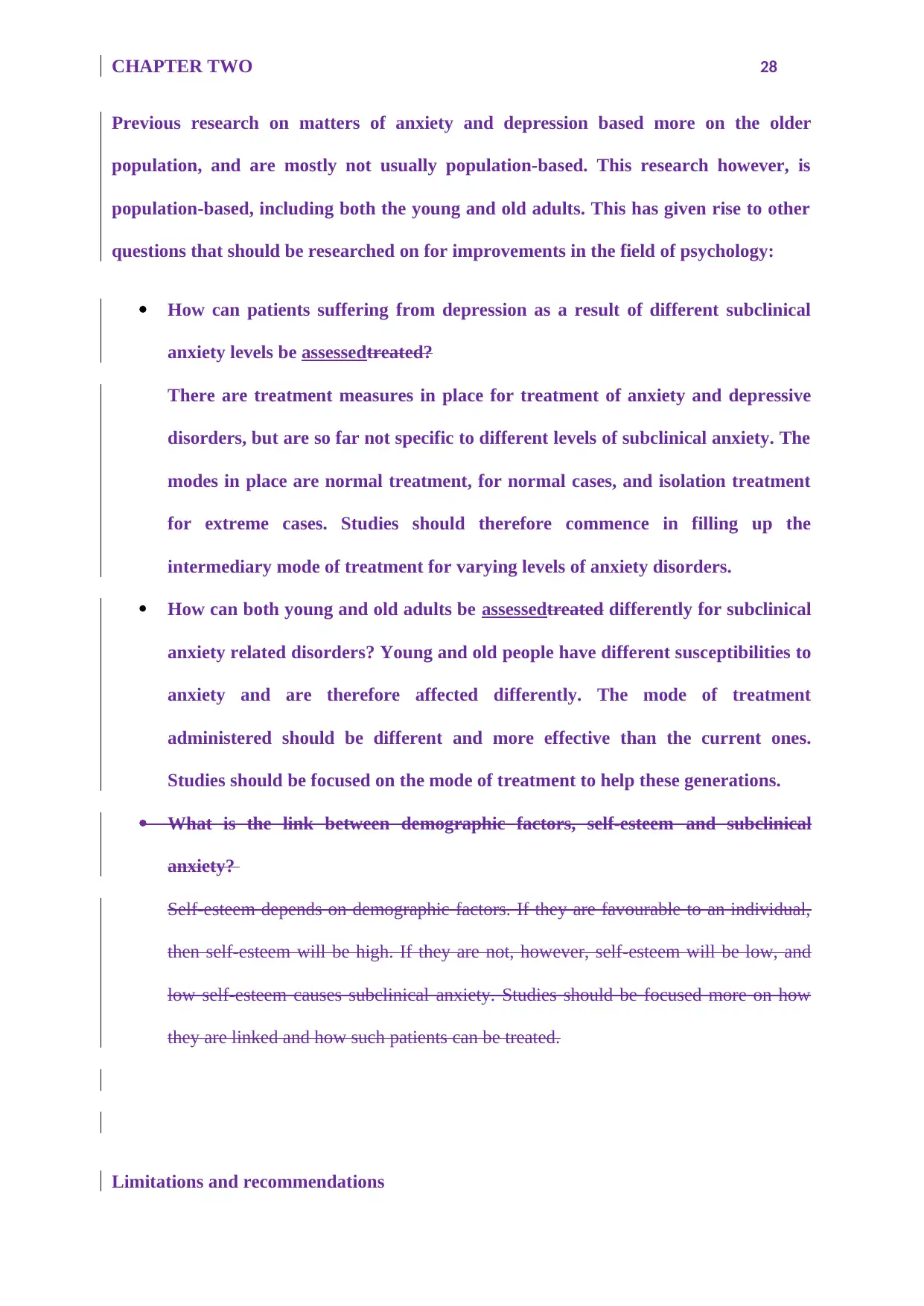
CHAPTER TWO 28
Previous research on matters of anxiety and depression based more on the older
population, and are mostly not usually population-based. This research however, is
population-based, including both the young and old adults. This has given rise to other
questions that should be researched on for improvements in the field of psychology:
How can patients suffering from depression as a result of different subclinical
anxiety levels be assessedtreated?
There are treatment measures in place for treatment of anxiety and depressive
disorders, but are so far not specific to different levels of subclinical anxiety. The
modes in place are normal treatment, for normal cases, and isolation treatment
for extreme cases. Studies should therefore commence in filling up the
intermediary mode of treatment for varying levels of anxiety disorders.
How can both young and old adults be assessedtreated differently for subclinical
anxiety related disorders? Young and old people have different susceptibilities to
anxiety and are therefore affected differently. The mode of treatment
administered should be different and more effective than the current ones.
Studies should be focused on the mode of treatment to help these generations.
What is the link between demographic factors, self-esteem and subclinical
anxiety?
Self-esteem depends on demographic factors. If they are favourable to an individual,
then self-esteem will be high. If they are not, however, self-esteem will be low, and
low self-esteem causes subclinical anxiety. Studies should be focused more on how
they are linked and how such patients can be treated.
Limitations and recommendations
Previous research on matters of anxiety and depression based more on the older
population, and are mostly not usually population-based. This research however, is
population-based, including both the young and old adults. This has given rise to other
questions that should be researched on for improvements in the field of psychology:
How can patients suffering from depression as a result of different subclinical
anxiety levels be assessedtreated?
There are treatment measures in place for treatment of anxiety and depressive
disorders, but are so far not specific to different levels of subclinical anxiety. The
modes in place are normal treatment, for normal cases, and isolation treatment
for extreme cases. Studies should therefore commence in filling up the
intermediary mode of treatment for varying levels of anxiety disorders.
How can both young and old adults be assessedtreated differently for subclinical
anxiety related disorders? Young and old people have different susceptibilities to
anxiety and are therefore affected differently. The mode of treatment
administered should be different and more effective than the current ones.
Studies should be focused on the mode of treatment to help these generations.
What is the link between demographic factors, self-esteem and subclinical
anxiety?
Self-esteem depends on demographic factors. If they are favourable to an individual,
then self-esteem will be high. If they are not, however, self-esteem will be low, and
low self-esteem causes subclinical anxiety. Studies should be focused more on how
they are linked and how such patients can be treated.
Limitations and recommendations
Secure Best Marks with AI Grader
Need help grading? Try our AI Grader for instant feedback on your assignments.

CHAPTER TWO 29
1. The sampling done during inclusion of participants was random, and was on a
voluntary basis. However, we would have had more accurate results if we had the
mandate to select suitable candidates for the study.
2. All the participants were in good health and no one suffered from cognitive
impairment. We therefore relied on their history of anxiety related events and possible
cognitive impairment they may have had, which was relatively inaccurate.
3. No one suffered from any anxiety disorder, so we couldn’t clearly compare between
clinical and non-clinical anxiety.
4. There were not enough older adults with or without subjective memory complaints, so
we couldn’t make conclusive comparisons between age, anxiety on subjective
memory
5. Most of the participants in their groups were at the same years of education, so this
could be the reason why we didn’t find any differences in anxiety levels correlation
with education levels.
6. In this study, we didn’t use any of the neurophysiological equipment (such as EEG or
FMRI machines) to see brain functions during testing thus all of the anatomical
relations in the study is theoretical.
7. The instruments used in collection of data including, PRMQ, BAI, STAI etc. do not
give 100% accuracy, and are therefore subjects to more scrutiny.
8. More studies should be centered on prevention and treatment of anxiety disorders at
its different levels of intensity.
9. Researchers should be allowed to assess and appoint candidates who will be relevant
to the study by themselves.
10. Psychology associations should invest more in the study of anxiety, depression and
cognition as it is an important and wide aspect of psychology that has not been tapped
into yet.
Demographic factors cause very little anxiety but should be studied in relation to self-esteem,
as this is directly related to anxiety in cases of very low feeling of self-worth.During the
research, the number of adults with or without subjective memory complaints was not
enough. We could not therefore make conclusive comparisons between age and anxiety on
subjective memory.
Most of the participants in their groups were at the same levels of education, or had had
almost the same amount of years of education in different fields. This could be the reason
why we did not find any differences in anxiety levels correlation with education levels.
We did not use any neurophysiological equipment, such as EEG or FMRI machines, to see
brain functions during testing thus all of the anatomical relations discussed in this study is
theoretical. Conclusive arguments can therefore not be drawn from these results.
The instruments used in data collection, including PRMQ, BAI. STAI, TAI, do not give
100% accuracy, and are therefore subjects to more scrutiny.
More studies should be centered on assessment of anxiety disorders at its different levels of
intensity.
1. The sampling done during inclusion of participants was random, and was on a
voluntary basis. However, we would have had more accurate results if we had the
mandate to select suitable candidates for the study.
2. All the participants were in good health and no one suffered from cognitive
impairment. We therefore relied on their history of anxiety related events and possible
cognitive impairment they may have had, which was relatively inaccurate.
3. No one suffered from any anxiety disorder, so we couldn’t clearly compare between
clinical and non-clinical anxiety.
4. There were not enough older adults with or without subjective memory complaints, so
we couldn’t make conclusive comparisons between age, anxiety on subjective
memory
5. Most of the participants in their groups were at the same years of education, so this
could be the reason why we didn’t find any differences in anxiety levels correlation
with education levels.
6. In this study, we didn’t use any of the neurophysiological equipment (such as EEG or
FMRI machines) to see brain functions during testing thus all of the anatomical
relations in the study is theoretical.
7. The instruments used in collection of data including, PRMQ, BAI, STAI etc. do not
give 100% accuracy, and are therefore subjects to more scrutiny.
8. More studies should be centered on prevention and treatment of anxiety disorders at
its different levels of intensity.
9. Researchers should be allowed to assess and appoint candidates who will be relevant
to the study by themselves.
10. Psychology associations should invest more in the study of anxiety, depression and
cognition as it is an important and wide aspect of psychology that has not been tapped
into yet.
Demographic factors cause very little anxiety but should be studied in relation to self-esteem,
as this is directly related to anxiety in cases of very low feeling of self-worth.During the
research, the number of adults with or without subjective memory complaints was not
enough. We could not therefore make conclusive comparisons between age and anxiety on
subjective memory.
Most of the participants in their groups were at the same levels of education, or had had
almost the same amount of years of education in different fields. This could be the reason
why we did not find any differences in anxiety levels correlation with education levels.
We did not use any neurophysiological equipment, such as EEG or FMRI machines, to see
brain functions during testing thus all of the anatomical relations discussed in this study is
theoretical. Conclusive arguments can therefore not be drawn from these results.
The instruments used in data collection, including PRMQ, BAI. STAI, TAI, do not give
100% accuracy, and are therefore subjects to more scrutiny.
More studies should be centered on assessment of anxiety disorders at its different levels of
intensity.
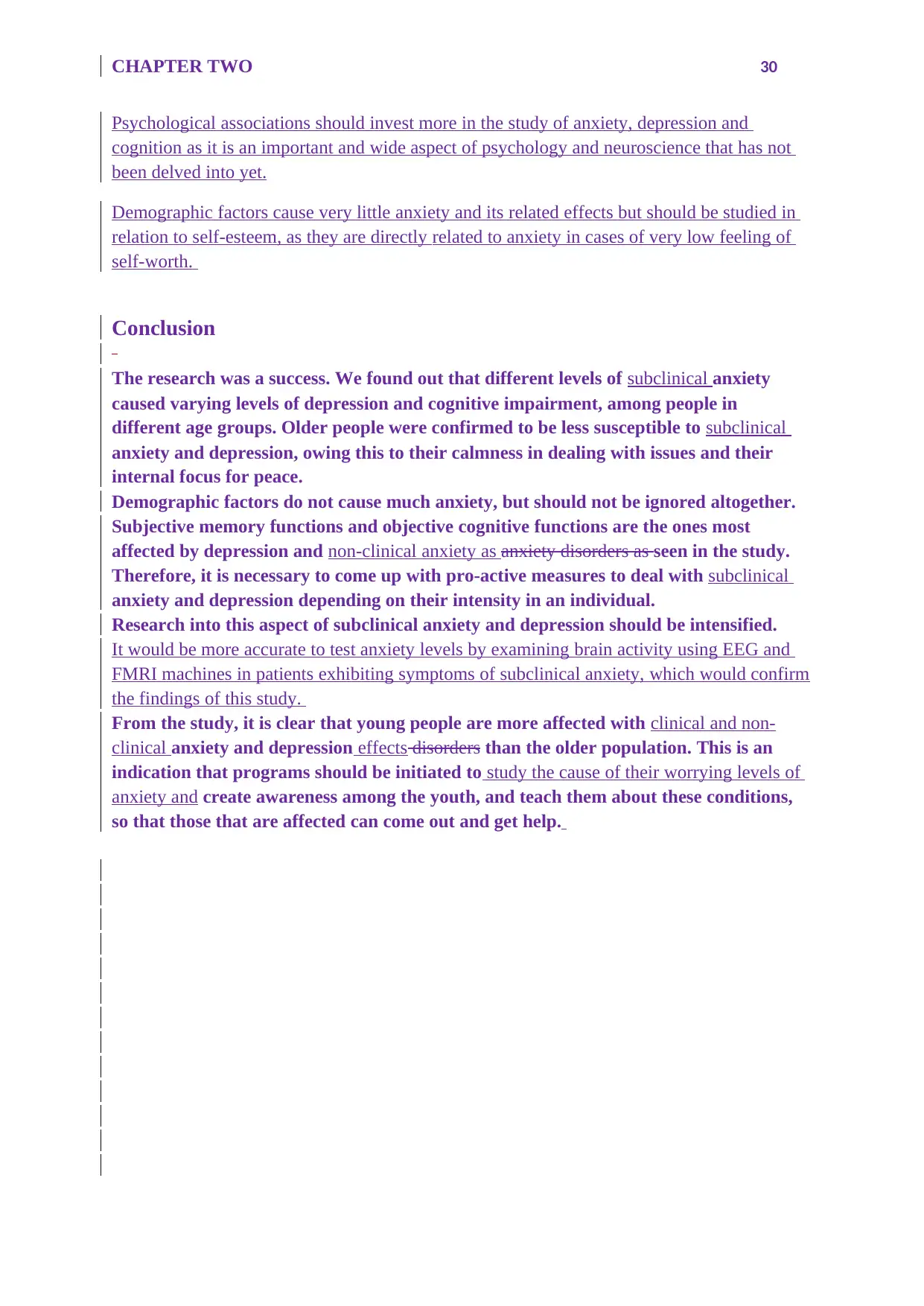
CHAPTER TWO 30
Psychological associations should invest more in the study of anxiety, depression and
cognition as it is an important and wide aspect of psychology and neuroscience that has not
been delved into yet.
Demographic factors cause very little anxiety and its related effects but should be studied in
relation to self-esteem, as they are directly related to anxiety in cases of very low feeling of
self-worth.
Conclusion
The research was a success. We found out that different levels of subclinical anxiety
caused varying levels of depression and cognitive impairment, among people in
different age groups. Older people were confirmed to be less susceptible to subclinical
anxiety and depression, owing this to their calmness in dealing with issues and their
internal focus for peace.
Demographic factors do not cause much anxiety, but should not be ignored altogether.
Subjective memory functions and objective cognitive functions are the ones most
affected by depression and non-clinical anxiety as anxiety disorders as seen in the study.
Therefore, it is necessary to come up with pro-active measures to deal with subclinical
anxiety and depression depending on their intensity in an individual.
Research into this aspect of subclinical anxiety and depression should be intensified.
It would be more accurate to test anxiety levels by examining brain activity using EEG and
FMRI machines in patients exhibiting symptoms of subclinical anxiety, which would confirm
the findings of this study.
From the study, it is clear that young people are more affected with clinical and non-
clinical anxiety and depression effects disorders than the older population. This is an
indication that programs should be initiated to study the cause of their worrying levels of
anxiety and create awareness among the youth, and teach them about these conditions,
so that those that are affected can come out and get help.
Psychological associations should invest more in the study of anxiety, depression and
cognition as it is an important and wide aspect of psychology and neuroscience that has not
been delved into yet.
Demographic factors cause very little anxiety and its related effects but should be studied in
relation to self-esteem, as they are directly related to anxiety in cases of very low feeling of
self-worth.
Conclusion
The research was a success. We found out that different levels of subclinical anxiety
caused varying levels of depression and cognitive impairment, among people in
different age groups. Older people were confirmed to be less susceptible to subclinical
anxiety and depression, owing this to their calmness in dealing with issues and their
internal focus for peace.
Demographic factors do not cause much anxiety, but should not be ignored altogether.
Subjective memory functions and objective cognitive functions are the ones most
affected by depression and non-clinical anxiety as anxiety disorders as seen in the study.
Therefore, it is necessary to come up with pro-active measures to deal with subclinical
anxiety and depression depending on their intensity in an individual.
Research into this aspect of subclinical anxiety and depression should be intensified.
It would be more accurate to test anxiety levels by examining brain activity using EEG and
FMRI machines in patients exhibiting symptoms of subclinical anxiety, which would confirm
the findings of this study.
From the study, it is clear that young people are more affected with clinical and non-
clinical anxiety and depression effects disorders than the older population. This is an
indication that programs should be initiated to study the cause of their worrying levels of
anxiety and create awareness among the youth, and teach them about these conditions,
so that those that are affected can come out and get help.
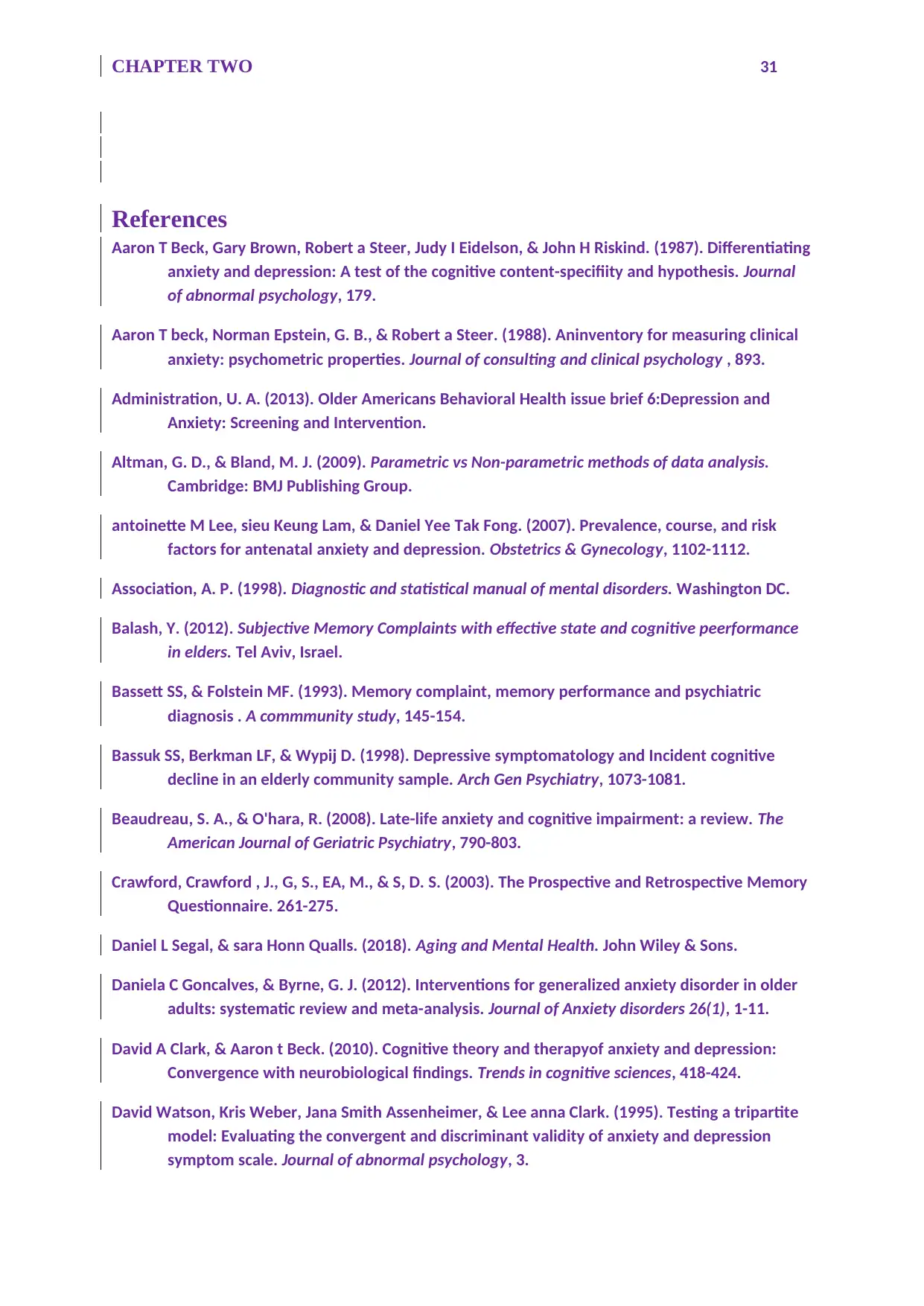
CHAPTER TWO 31
References
Aaron T Beck, Gary Brown, Robert a Steer, Judy I Eidelson, & John H Riskind. (1987). Differentiating
anxiety and depression: A test of the cognitive content-specifiity and hypothesis. Journal
of abnormal psychology, 179.
Aaron T beck, Norman Epstein, G. B., & Robert a Steer. (1988). Aninventory for measuring clinical
anxiety: psychometric properties. Journal of consulting and clinical psychology , 893.
Administration, U. A. (2013). Older Americans Behavioral Health issue brief 6:Depression and
Anxiety: Screening and Intervention.
Altman, G. D., & Bland, M. J. (2009). Parametric vs Non-parametric methods of data analysis.
Cambridge: BMJ Publishing Group.
antoinette M Lee, sieu Keung Lam, & Daniel Yee Tak Fong. (2007). Prevalence, course, and risk
factors for antenatal anxiety and depression. Obstetrics & Gynecology, 1102-1112.
Association, A. P. (1998). Diagnostic and statistical manual of mental disorders. Washington DC.
Balash, Y. (2012). Subjective Memory Complaints with effective state and cognitive peerformance
in elders. Tel Aviv, Israel.
Bassett SS, & Folstein MF. (1993). Memory complaint, memory performance and psychiatric
diagnosis . A commmunity study, 145-154.
Bassuk SS, Berkman LF, & Wypij D. (1998). Depressive symptomatology and Incident cognitive
decline in an elderly community sample. Arch Gen Psychiatry, 1073-1081.
Beaudreau, S. A., & O'hara, R. (2008). Late-life anxiety and cognitive impairment: a review. The
American Journal of Geriatric Psychiatry, 790-803.
Crawford, Crawford , J., G, S., EA, M., & S, D. S. (2003). The Prospective and Retrospective Memory
Questionnaire. 261-275.
Daniel L Segal, & sara Honn Qualls. (2018). Aging and Mental Health. John Wiley & Sons.
Daniela C Goncalves, & Byrne, G. J. (2012). Interventions for generalized anxiety disorder in older
adults: systematic review and meta-analysis. Journal of Anxiety disorders 26(1), 1-11.
David A Clark, & Aaron t Beck. (2010). Cognitive theory and therapyof anxiety and depression:
Convergence with neurobiological findings. Trends in cognitive sciences, 418-424.
David Watson, Kris Weber, Jana Smith Assenheimer, & Lee anna Clark. (1995). Testing a tripartite
model: Evaluating the convergent and discriminant validity of anxiety and depression
symptom scale. Journal of abnormal psychology, 3.
References
Aaron T Beck, Gary Brown, Robert a Steer, Judy I Eidelson, & John H Riskind. (1987). Differentiating
anxiety and depression: A test of the cognitive content-specifiity and hypothesis. Journal
of abnormal psychology, 179.
Aaron T beck, Norman Epstein, G. B., & Robert a Steer. (1988). Aninventory for measuring clinical
anxiety: psychometric properties. Journal of consulting and clinical psychology , 893.
Administration, U. A. (2013). Older Americans Behavioral Health issue brief 6:Depression and
Anxiety: Screening and Intervention.
Altman, G. D., & Bland, M. J. (2009). Parametric vs Non-parametric methods of data analysis.
Cambridge: BMJ Publishing Group.
antoinette M Lee, sieu Keung Lam, & Daniel Yee Tak Fong. (2007). Prevalence, course, and risk
factors for antenatal anxiety and depression. Obstetrics & Gynecology, 1102-1112.
Association, A. P. (1998). Diagnostic and statistical manual of mental disorders. Washington DC.
Balash, Y. (2012). Subjective Memory Complaints with effective state and cognitive peerformance
in elders. Tel Aviv, Israel.
Bassett SS, & Folstein MF. (1993). Memory complaint, memory performance and psychiatric
diagnosis . A commmunity study, 145-154.
Bassuk SS, Berkman LF, & Wypij D. (1998). Depressive symptomatology and Incident cognitive
decline in an elderly community sample. Arch Gen Psychiatry, 1073-1081.
Beaudreau, S. A., & O'hara, R. (2008). Late-life anxiety and cognitive impairment: a review. The
American Journal of Geriatric Psychiatry, 790-803.
Crawford, Crawford , J., G, S., EA, M., & S, D. S. (2003). The Prospective and Retrospective Memory
Questionnaire. 261-275.
Daniel L Segal, & sara Honn Qualls. (2018). Aging and Mental Health. John Wiley & Sons.
Daniela C Goncalves, & Byrne, G. J. (2012). Interventions for generalized anxiety disorder in older
adults: systematic review and meta-analysis. Journal of Anxiety disorders 26(1), 1-11.
David A Clark, & Aaron t Beck. (2010). Cognitive theory and therapyof anxiety and depression:
Convergence with neurobiological findings. Trends in cognitive sciences, 418-424.
David Watson, Kris Weber, Jana Smith Assenheimer, & Lee anna Clark. (1995). Testing a tripartite
model: Evaluating the convergent and discriminant validity of anxiety and depression
symptom scale. Journal of abnormal psychology, 3.
Paraphrase This Document
Need a fresh take? Get an instant paraphrase of this document with our AI Paraphraser
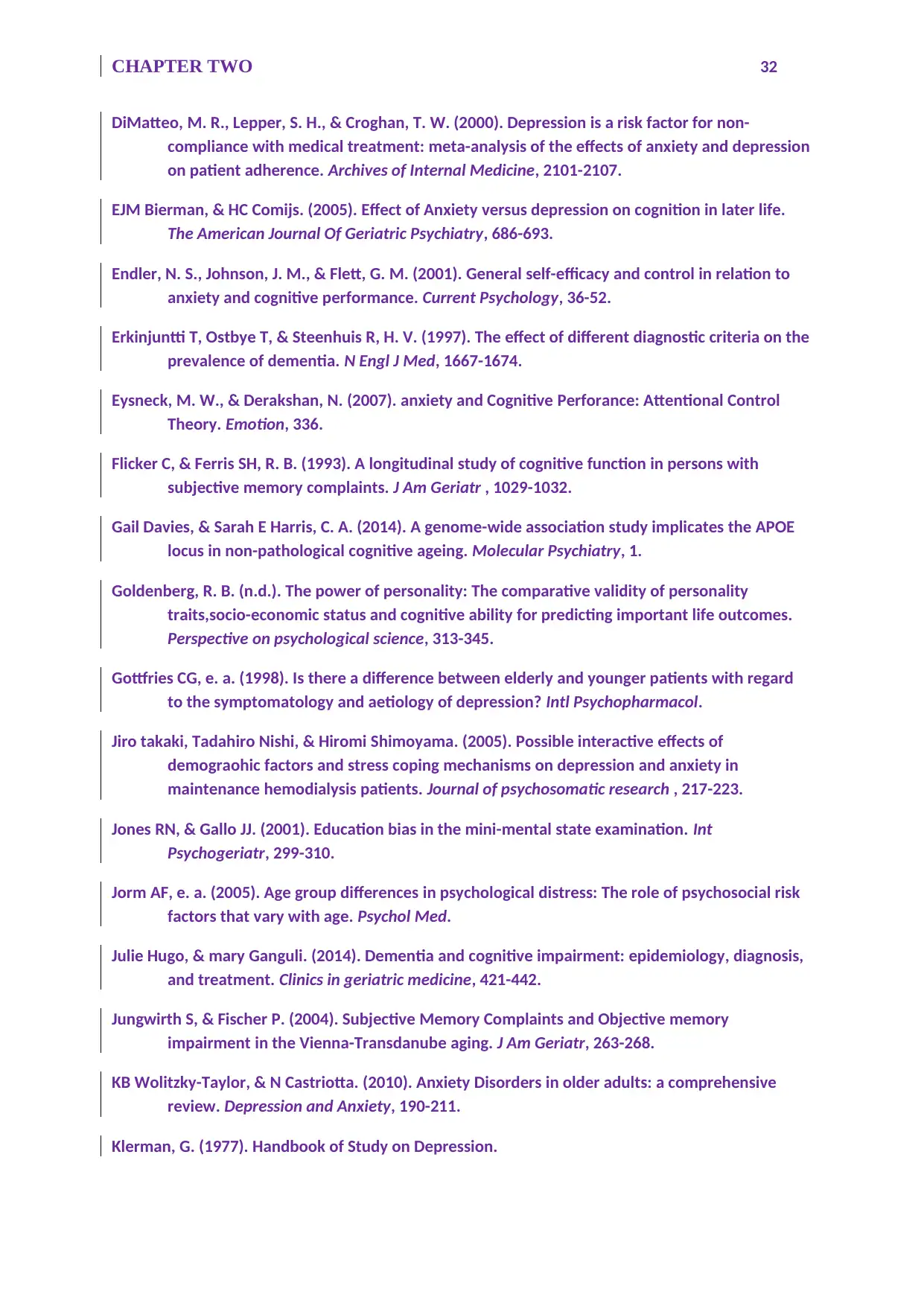
CHAPTER TWO 32
DiMatteo, M. R., Lepper, S. H., & Croghan, T. W. (2000). Depression is a risk factor for non-
compliance with medical treatment: meta-analysis of the effects of anxiety and depression
on patient adherence. Archives of Internal Medicine, 2101-2107.
EJM Bierman, & HC Comijs. (2005). Effect of Anxiety versus depression on cognition in later life.
The American Journal Of Geriatric Psychiatry, 686-693.
Endler, N. S., Johnson, J. M., & Flett, G. M. (2001). General self-efficacy and control in relation to
anxiety and cognitive performance. Current Psychology, 36-52.
Erkinjuntti T, Ostbye T, & Steenhuis R, H. V. (1997). The effect of different diagnostic criteria on the
prevalence of dementia. N Engl J Med, 1667-1674.
Eysneck, M. W., & Derakshan, N. (2007). anxiety and Cognitive Perforance: Attentional Control
Theory. Emotion, 336.
Flicker C, & Ferris SH, R. B. (1993). A longitudinal study of cognitive function in persons with
subjective memory complaints. J Am Geriatr , 1029-1032.
Gail Davies, & Sarah E Harris, C. A. (2014). A genome-wide association study implicates the APOE
locus in non-pathological cognitive ageing. Molecular Psychiatry, 1.
Goldenberg, R. B. (n.d.). The power of personality: The comparative validity of personality
traits,socio-economic status and cognitive ability for predicting important life outcomes.
Perspective on psychological science, 313-345.
Gottfries CG, e. a. (1998). Is there a difference between elderly and younger patients with regard
to the symptomatology and aetiology of depression? Intl Psychopharmacol.
Jiro takaki, Tadahiro Nishi, & Hiromi Shimoyama. (2005). Possible interactive effects of
demograohic factors and stress coping mechanisms on depression and anxiety in
maintenance hemodialysis patients. Journal of psychosomatic research , 217-223.
Jones RN, & Gallo JJ. (2001). Education bias in the mini-mental state examination. Int
Psychogeriatr, 299-310.
Jorm AF, e. a. (2005). Age group differences in psychological distress: The role of psychosocial risk
factors that vary with age. Psychol Med.
Julie Hugo, & mary Ganguli. (2014). Dementia and cognitive impairment: epidemiology, diagnosis,
and treatment. Clinics in geriatric medicine, 421-442.
Jungwirth S, & Fischer P. (2004). Subjective Memory Complaints and Objective memory
impairment in the Vienna-Transdanube aging. J Am Geriatr, 263-268.
KB Wolitzky-Taylor, & N Castriotta. (2010). Anxiety Disorders in older adults: a comprehensive
review. Depression and Anxiety, 190-211.
Klerman, G. (1977). Handbook of Study on Depression.
DiMatteo, M. R., Lepper, S. H., & Croghan, T. W. (2000). Depression is a risk factor for non-
compliance with medical treatment: meta-analysis of the effects of anxiety and depression
on patient adherence. Archives of Internal Medicine, 2101-2107.
EJM Bierman, & HC Comijs. (2005). Effect of Anxiety versus depression on cognition in later life.
The American Journal Of Geriatric Psychiatry, 686-693.
Endler, N. S., Johnson, J. M., & Flett, G. M. (2001). General self-efficacy and control in relation to
anxiety and cognitive performance. Current Psychology, 36-52.
Erkinjuntti T, Ostbye T, & Steenhuis R, H. V. (1997). The effect of different diagnostic criteria on the
prevalence of dementia. N Engl J Med, 1667-1674.
Eysneck, M. W., & Derakshan, N. (2007). anxiety and Cognitive Perforance: Attentional Control
Theory. Emotion, 336.
Flicker C, & Ferris SH, R. B. (1993). A longitudinal study of cognitive function in persons with
subjective memory complaints. J Am Geriatr , 1029-1032.
Gail Davies, & Sarah E Harris, C. A. (2014). A genome-wide association study implicates the APOE
locus in non-pathological cognitive ageing. Molecular Psychiatry, 1.
Goldenberg, R. B. (n.d.). The power of personality: The comparative validity of personality
traits,socio-economic status and cognitive ability for predicting important life outcomes.
Perspective on psychological science, 313-345.
Gottfries CG, e. a. (1998). Is there a difference between elderly and younger patients with regard
to the symptomatology and aetiology of depression? Intl Psychopharmacol.
Jiro takaki, Tadahiro Nishi, & Hiromi Shimoyama. (2005). Possible interactive effects of
demograohic factors and stress coping mechanisms on depression and anxiety in
maintenance hemodialysis patients. Journal of psychosomatic research , 217-223.
Jones RN, & Gallo JJ. (2001). Education bias in the mini-mental state examination. Int
Psychogeriatr, 299-310.
Jorm AF, e. a. (2005). Age group differences in psychological distress: The role of psychosocial risk
factors that vary with age. Psychol Med.
Julie Hugo, & mary Ganguli. (2014). Dementia and cognitive impairment: epidemiology, diagnosis,
and treatment. Clinics in geriatric medicine, 421-442.
Jungwirth S, & Fischer P. (2004). Subjective Memory Complaints and Objective memory
impairment in the Vienna-Transdanube aging. J Am Geriatr, 263-268.
KB Wolitzky-Taylor, & N Castriotta. (2010). Anxiety Disorders in older adults: a comprehensive
review. Depression and Anxiety, 190-211.
Klerman, G. (1977). Handbook of Study on Depression.
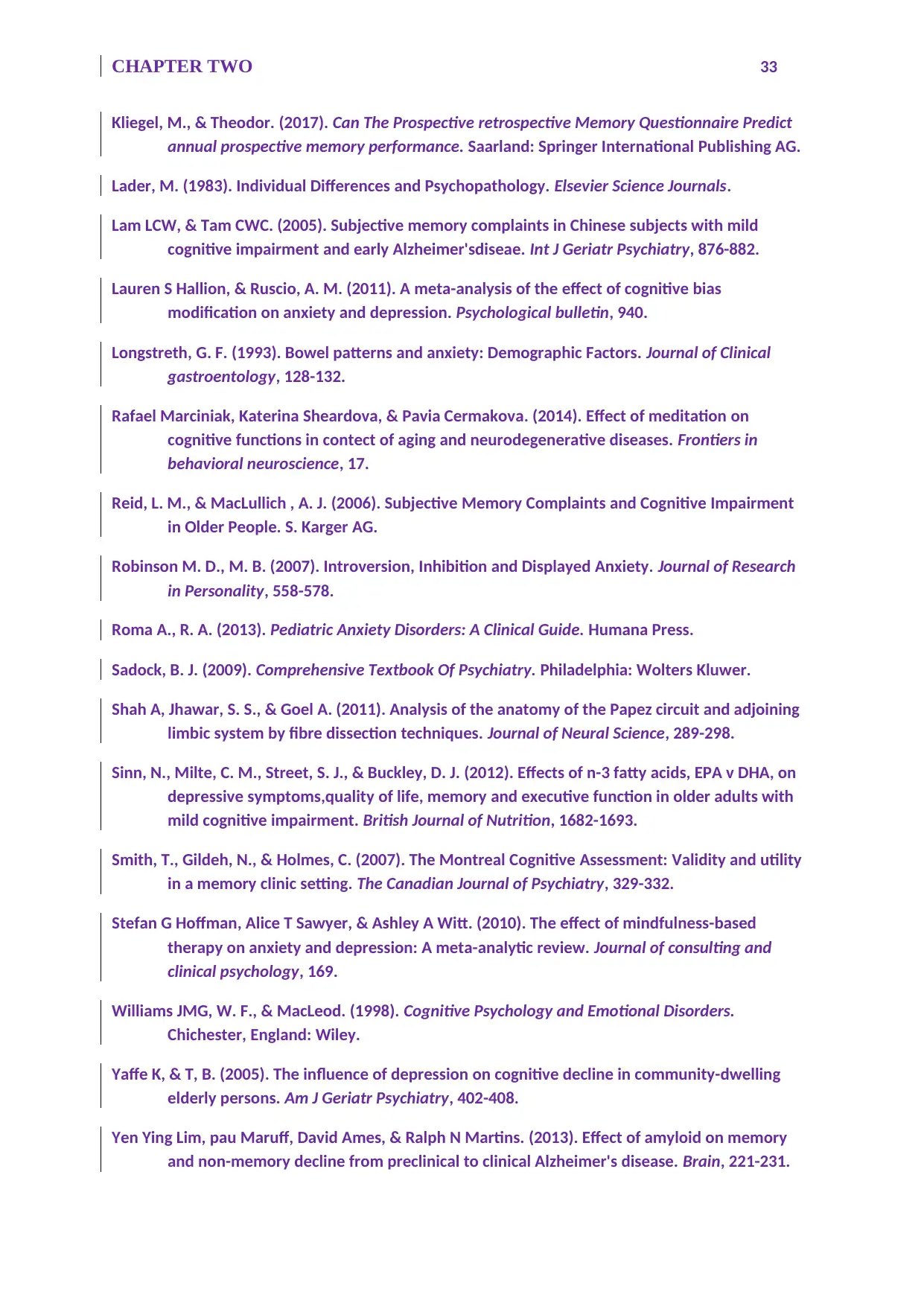
CHAPTER TWO 33
Kliegel, M., & Theodor. (2017). Can The Prospective retrospective Memory Questionnaire Predict
annual prospective memory performance. Saarland: Springer International Publishing AG.
Lader, M. (1983). Individual Differences and Psychopathology. Elsevier Science Journals.
Lam LCW, & Tam CWC. (2005). Subjective memory complaints in Chinese subjects with mild
cognitive impairment and early Alzheimer'sdiseae. Int J Geriatr Psychiatry, 876-882.
Lauren S Hallion, & Ruscio, A. M. (2011). A meta-analysis of the effect of cognitive bias
modification on anxiety and depression. Psychological bulletin, 940.
Longstreth, G. F. (1993). Bowel patterns and anxiety: Demographic Factors. Journal of Clinical
gastroentology, 128-132.
Rafael Marciniak, Katerina Sheardova, & Pavia Cermakova. (2014). Effect of meditation on
cognitive functions in contect of aging and neurodegenerative diseases. Frontiers in
behavioral neuroscience, 17.
Reid, L. M., & MacLullich , A. J. (2006). Subjective Memory Complaints and Cognitive Impairment
in Older People. S. Karger AG.
Robinson M. D., M. B. (2007). Introversion, Inhibition and Displayed Anxiety. Journal of Research
in Personality, 558-578.
Roma A., R. A. (2013). Pediatric Anxiety Disorders: A Clinical Guide. Humana Press.
Sadock, B. J. (2009). Comprehensive Textbook Of Psychiatry. Philadelphia: Wolters Kluwer.
Shah A, Jhawar, S. S., & Goel A. (2011). Analysis of the anatomy of the Papez circuit and adjoining
limbic system by fibre dissection techniques. Journal of Neural Science, 289-298.
Sinn, N., Milte, C. M., Street, S. J., & Buckley, D. J. (2012). Effects of n-3 fatty acids, EPA v DHA, on
depressive symptoms,quality of life, memory and executive function in older adults with
mild cognitive impairment. British Journal of Nutrition, 1682-1693.
Smith, T., Gildeh, N., & Holmes, C. (2007). The Montreal Cognitive Assessment: Validity and utility
in a memory clinic setting. The Canadian Journal of Psychiatry, 329-332.
Stefan G Hoffman, Alice T Sawyer, & Ashley A Witt. (2010). The effect of mindfulness-based
therapy on anxiety and depression: A meta-analytic review. Journal of consulting and
clinical psychology, 169.
Williams JMG, W. F., & MacLeod. (1998). Cognitive Psychology and Emotional Disorders.
Chichester, England: Wiley.
Yaffe K, & T, B. (2005). The influence of depression on cognitive decline in community-dwelling
elderly persons. Am J Geriatr Psychiatry, 402-408.
Yen Ying Lim, pau Maruff, David Ames, & Ralph N Martins. (2013). Effect of amyloid on memory
and non-memory decline from preclinical to clinical Alzheimer's disease. Brain, 221-231.
Kliegel, M., & Theodor. (2017). Can The Prospective retrospective Memory Questionnaire Predict
annual prospective memory performance. Saarland: Springer International Publishing AG.
Lader, M. (1983). Individual Differences and Psychopathology. Elsevier Science Journals.
Lam LCW, & Tam CWC. (2005). Subjective memory complaints in Chinese subjects with mild
cognitive impairment and early Alzheimer'sdiseae. Int J Geriatr Psychiatry, 876-882.
Lauren S Hallion, & Ruscio, A. M. (2011). A meta-analysis of the effect of cognitive bias
modification on anxiety and depression. Psychological bulletin, 940.
Longstreth, G. F. (1993). Bowel patterns and anxiety: Demographic Factors. Journal of Clinical
gastroentology, 128-132.
Rafael Marciniak, Katerina Sheardova, & Pavia Cermakova. (2014). Effect of meditation on
cognitive functions in contect of aging and neurodegenerative diseases. Frontiers in
behavioral neuroscience, 17.
Reid, L. M., & MacLullich , A. J. (2006). Subjective Memory Complaints and Cognitive Impairment
in Older People. S. Karger AG.
Robinson M. D., M. B. (2007). Introversion, Inhibition and Displayed Anxiety. Journal of Research
in Personality, 558-578.
Roma A., R. A. (2013). Pediatric Anxiety Disorders: A Clinical Guide. Humana Press.
Sadock, B. J. (2009). Comprehensive Textbook Of Psychiatry. Philadelphia: Wolters Kluwer.
Shah A, Jhawar, S. S., & Goel A. (2011). Analysis of the anatomy of the Papez circuit and adjoining
limbic system by fibre dissection techniques. Journal of Neural Science, 289-298.
Sinn, N., Milte, C. M., Street, S. J., & Buckley, D. J. (2012). Effects of n-3 fatty acids, EPA v DHA, on
depressive symptoms,quality of life, memory and executive function in older adults with
mild cognitive impairment. British Journal of Nutrition, 1682-1693.
Smith, T., Gildeh, N., & Holmes, C. (2007). The Montreal Cognitive Assessment: Validity and utility
in a memory clinic setting. The Canadian Journal of Psychiatry, 329-332.
Stefan G Hoffman, Alice T Sawyer, & Ashley A Witt. (2010). The effect of mindfulness-based
therapy on anxiety and depression: A meta-analytic review. Journal of consulting and
clinical psychology, 169.
Williams JMG, W. F., & MacLeod. (1998). Cognitive Psychology and Emotional Disorders.
Chichester, England: Wiley.
Yaffe K, & T, B. (2005). The influence of depression on cognitive decline in community-dwelling
elderly persons. Am J Geriatr Psychiatry, 402-408.
Yen Ying Lim, pau Maruff, David Ames, & Ralph N Martins. (2013). Effect of amyloid on memory
and non-memory decline from preclinical to clinical Alzheimer's disease. Brain, 221-231.

CHAPTER TWO 34
Zelinski EM, & Cr., A.-B. (1990). Memory Functioning Questionnaire: Concurrent validity with
memory performance and self reported memory failures . Psychol Aging , 388-399.
Zelinski EM, & Cr., A.-B. (1990). Memory Functioning Questionnaire: Concurrent validity with
memory performance and self reported memory failures . Psychol Aging , 388-399.
1 out of 34
Related Documents
Your All-in-One AI-Powered Toolkit for Academic Success.
+13062052269
info@desklib.com
Available 24*7 on WhatsApp / Email
![[object Object]](/_next/static/media/star-bottom.7253800d.svg)
Unlock your academic potential
© 2024 | Zucol Services PVT LTD | All rights reserved.





